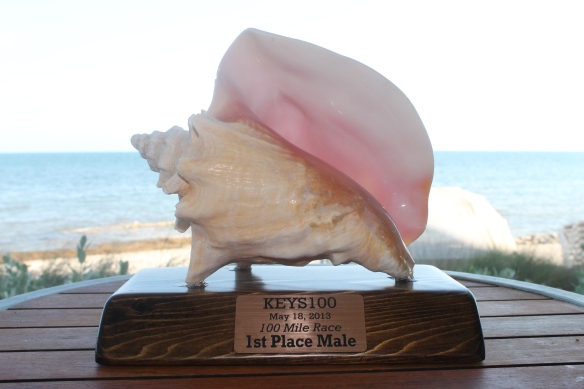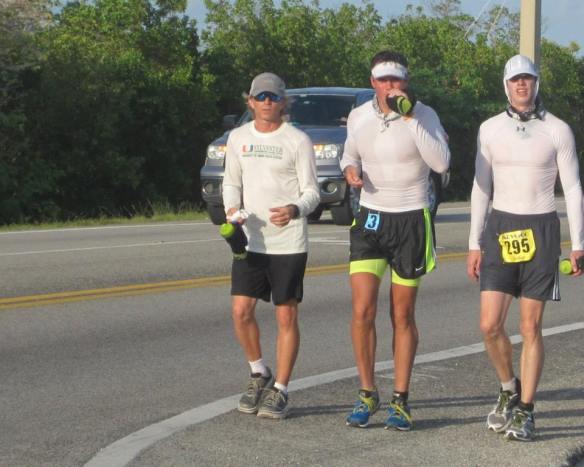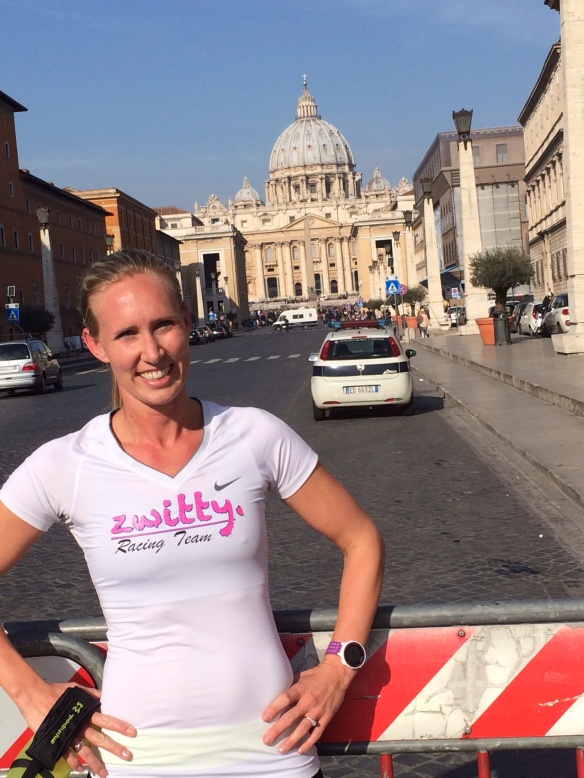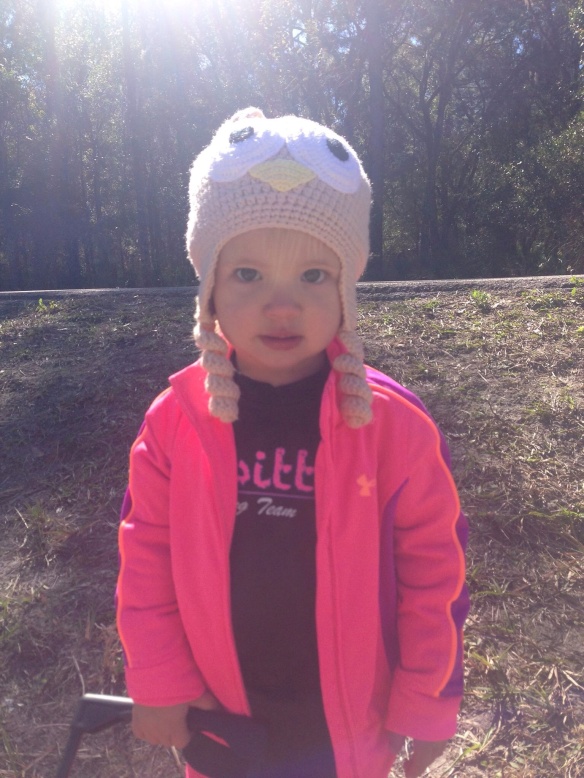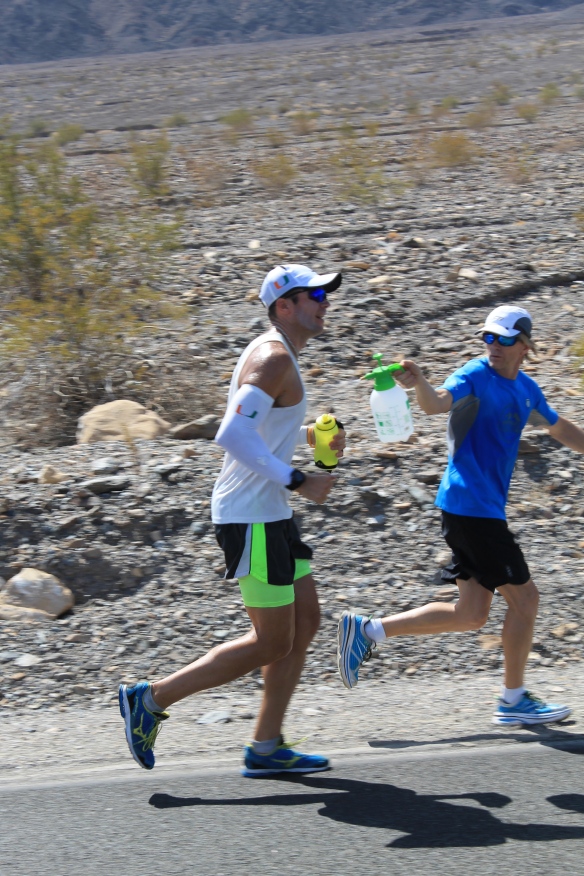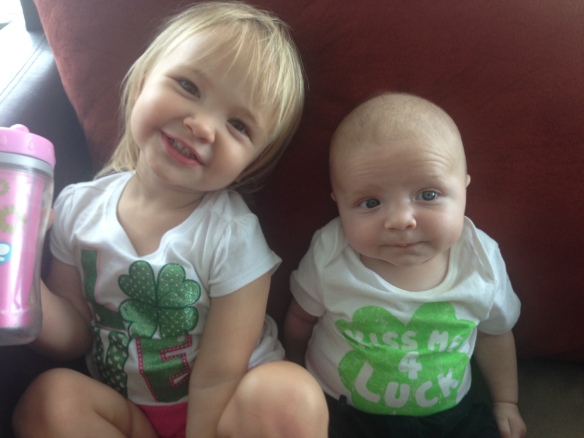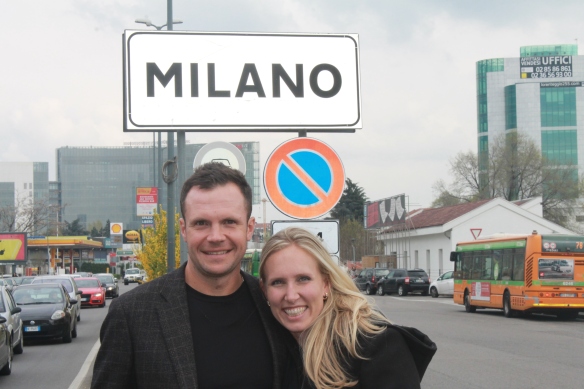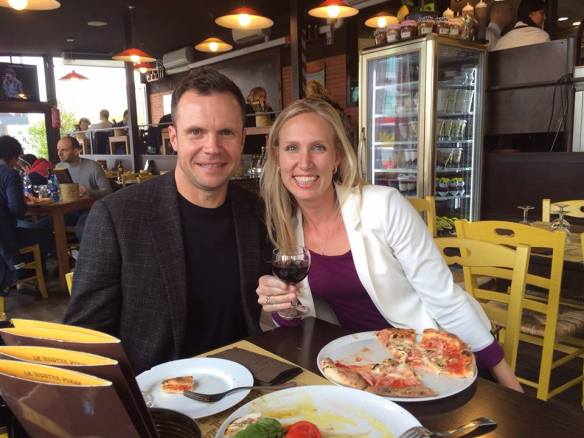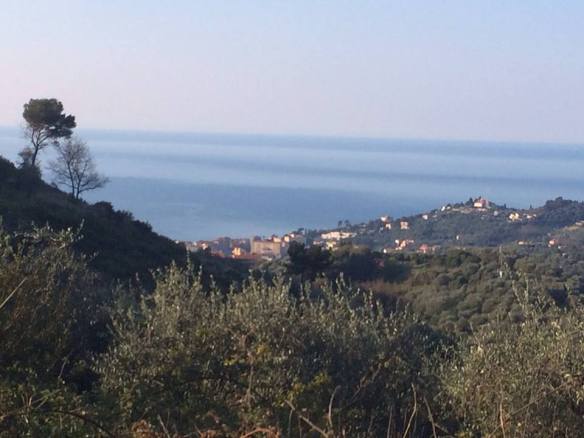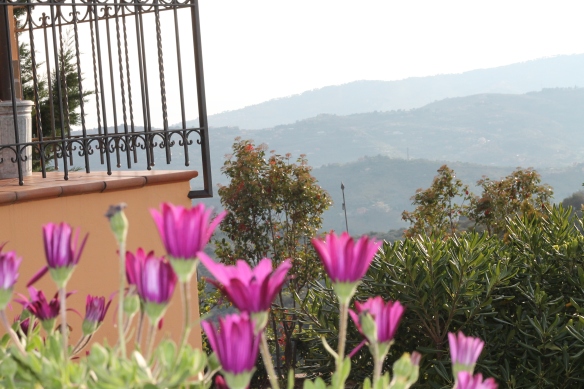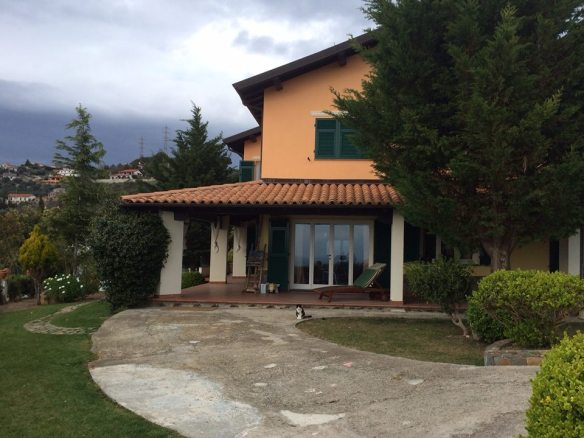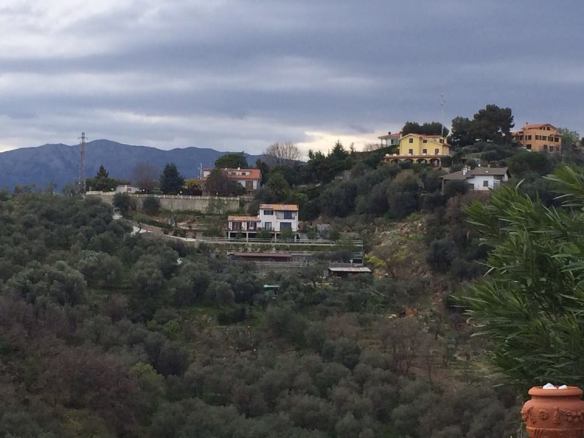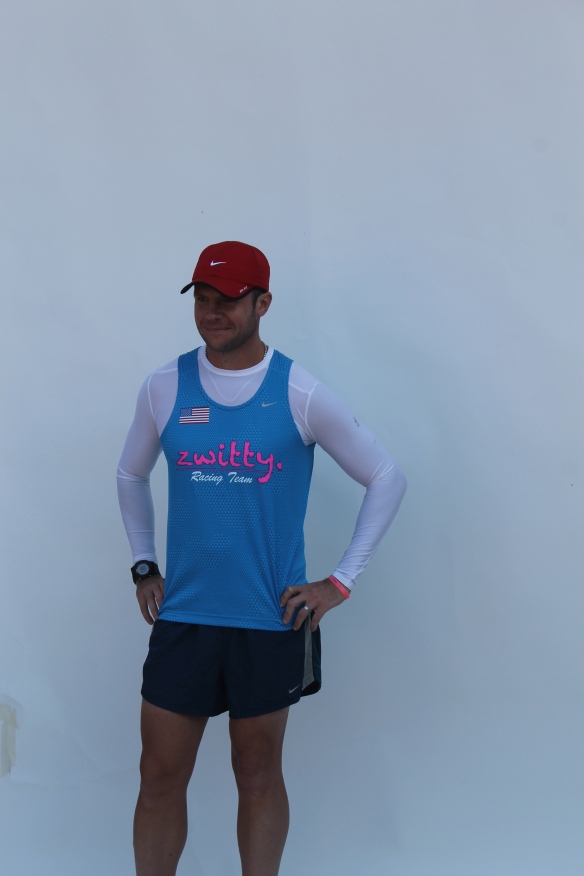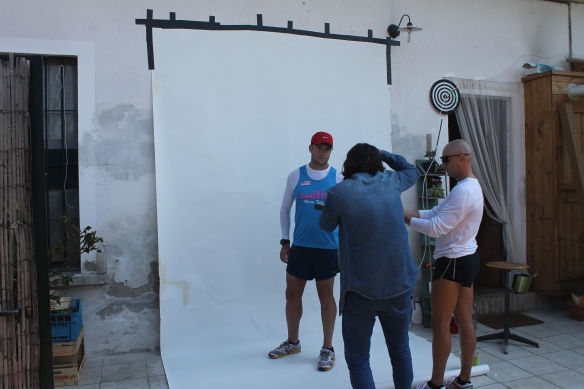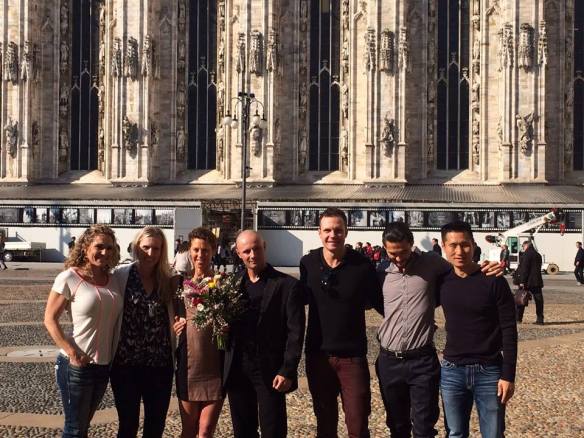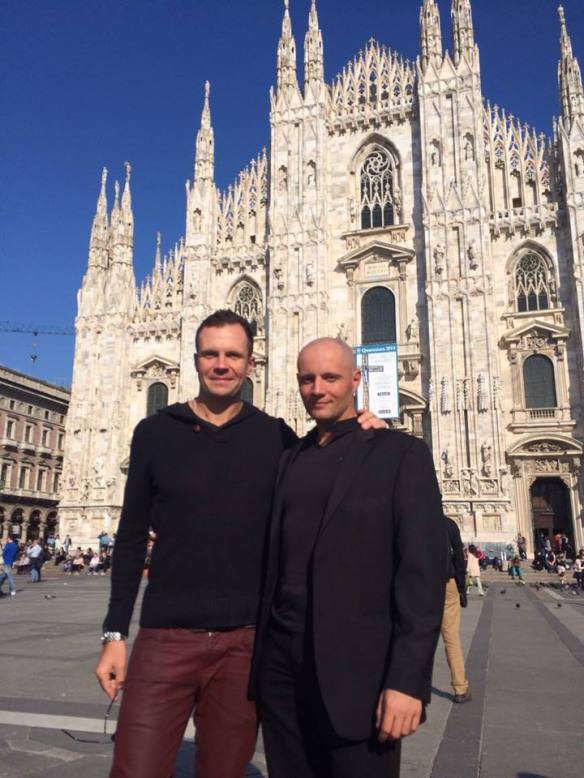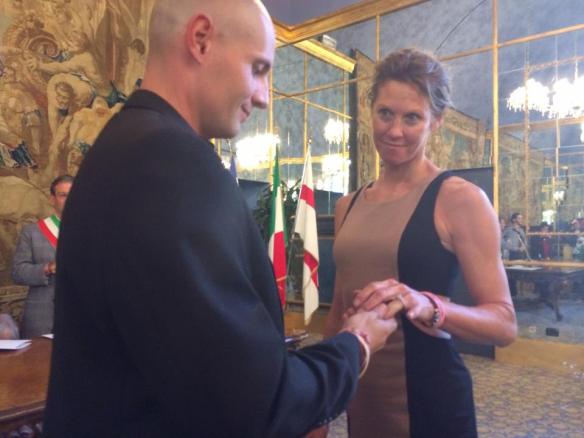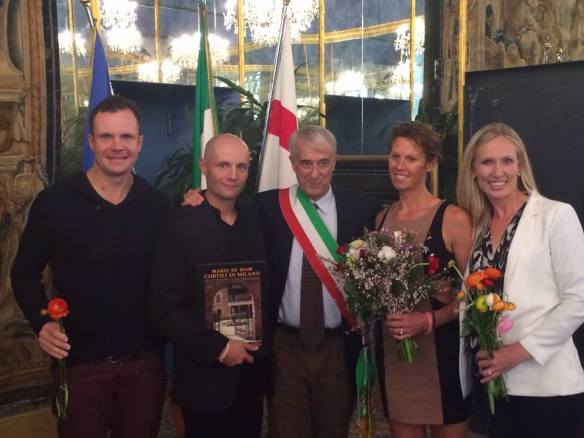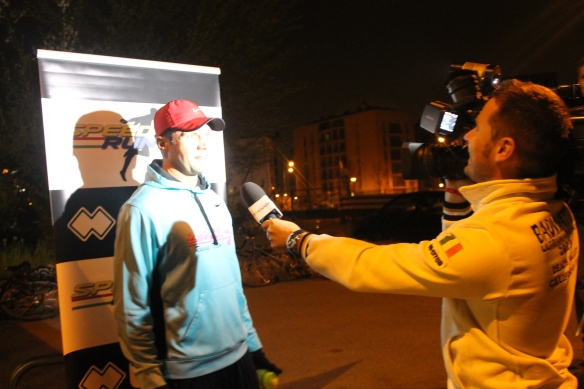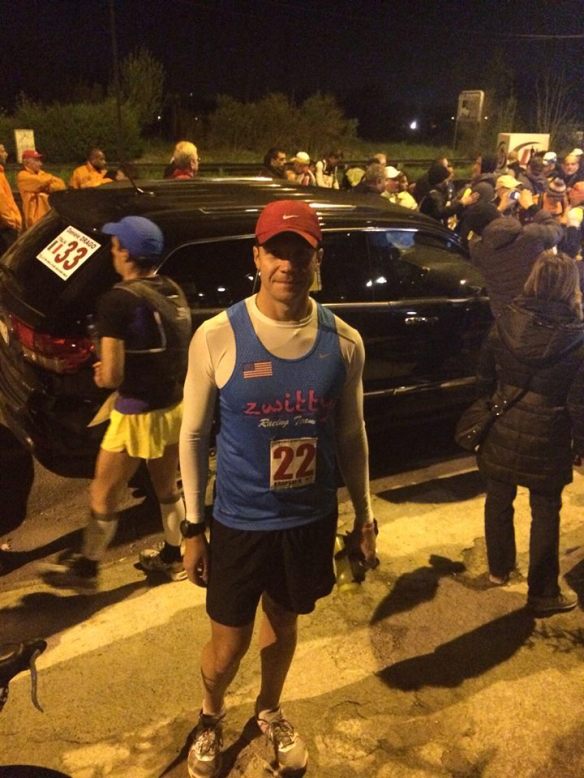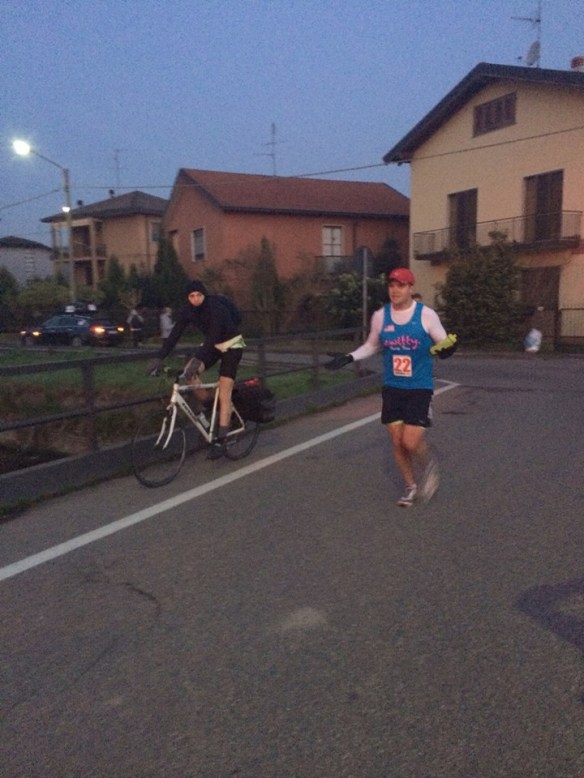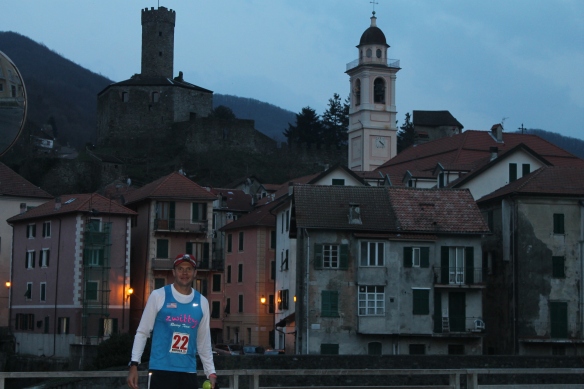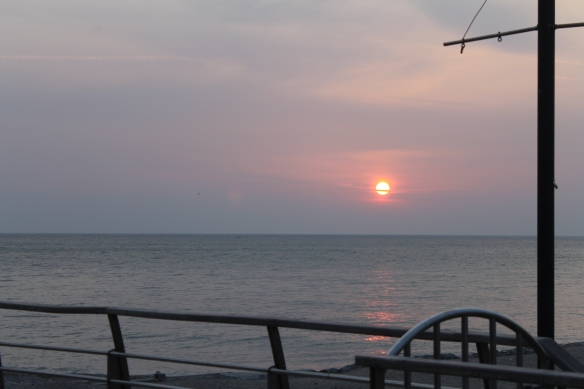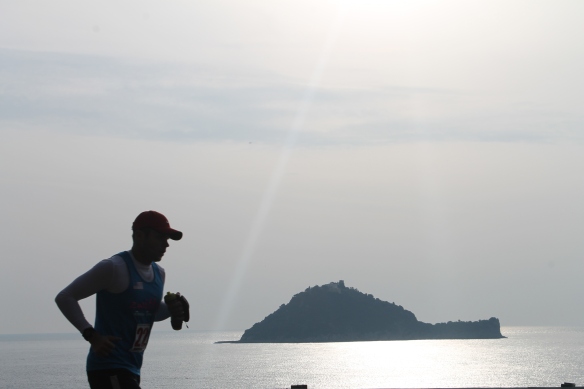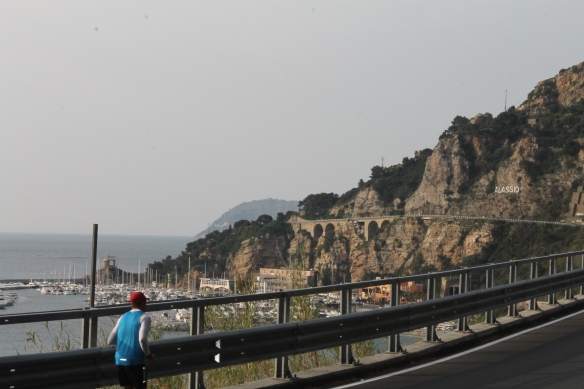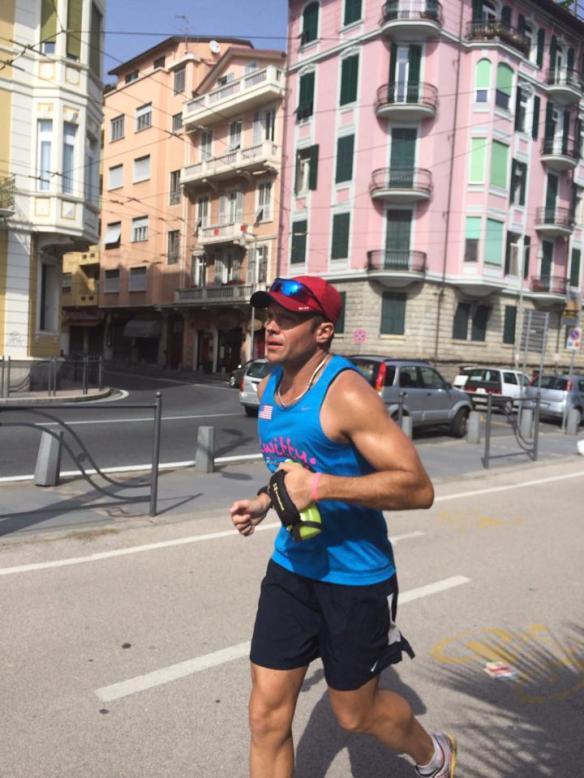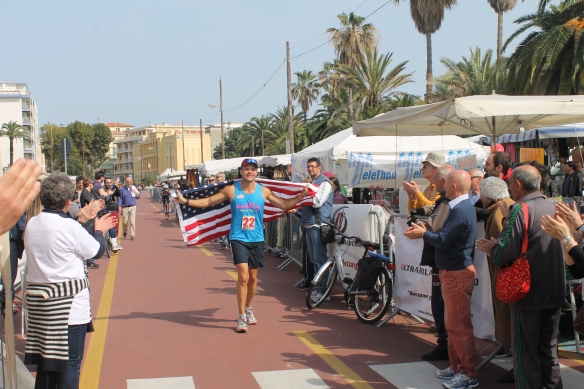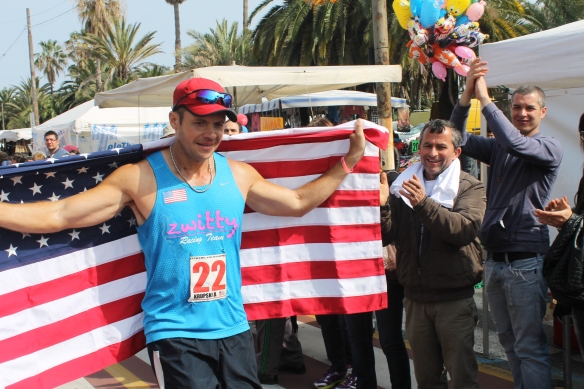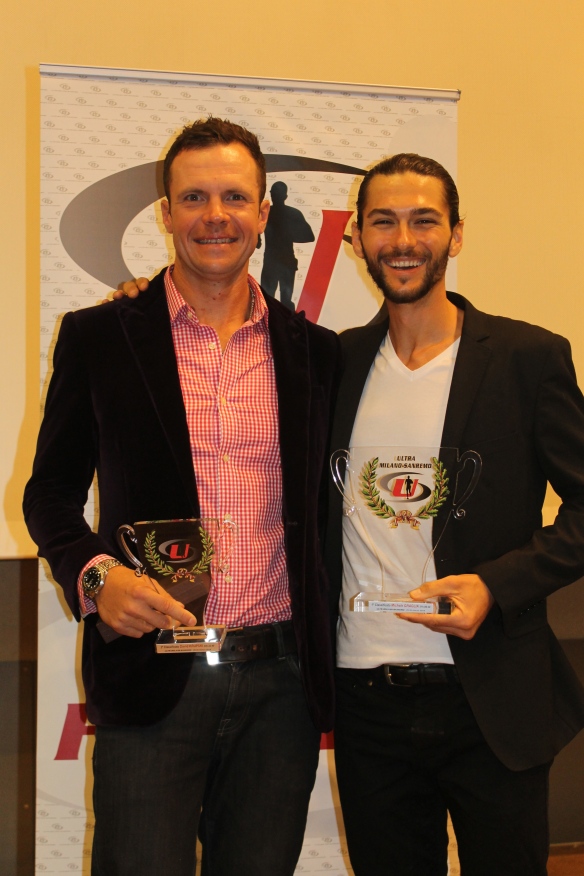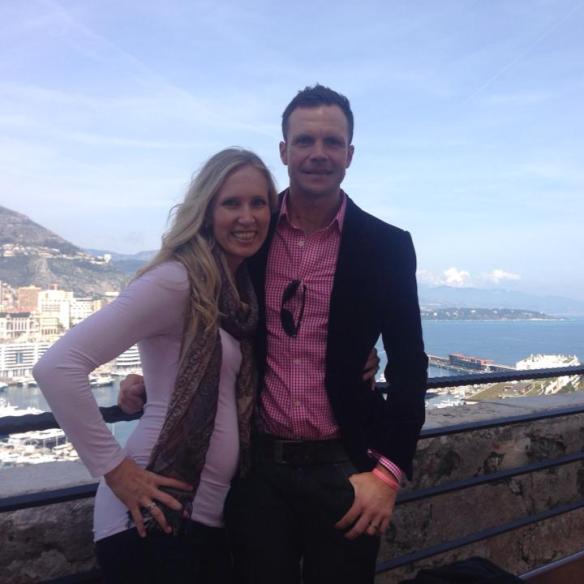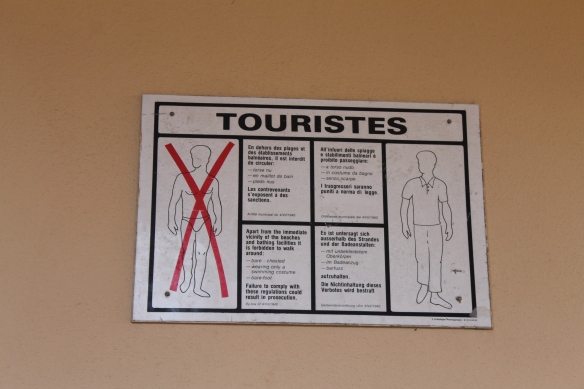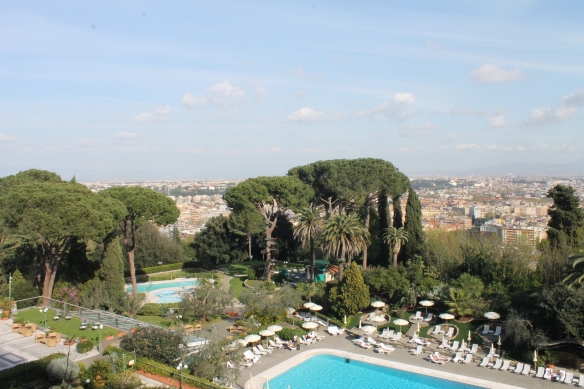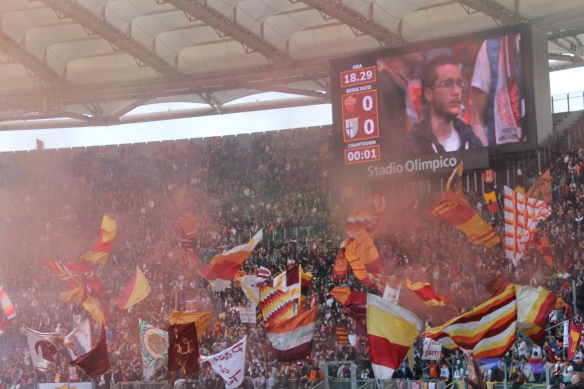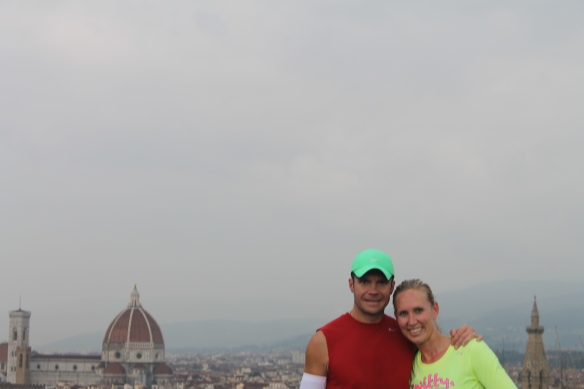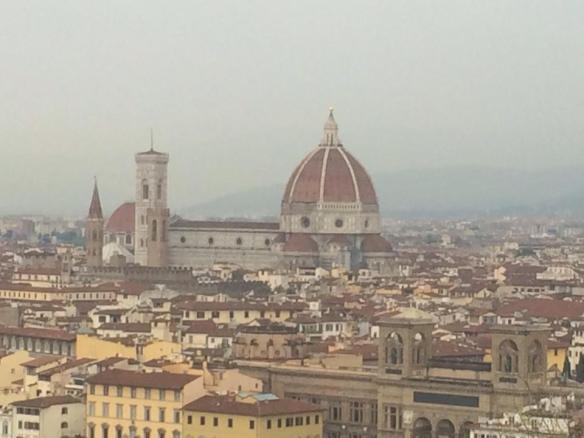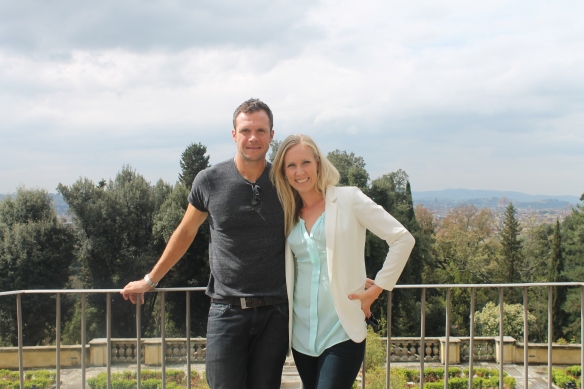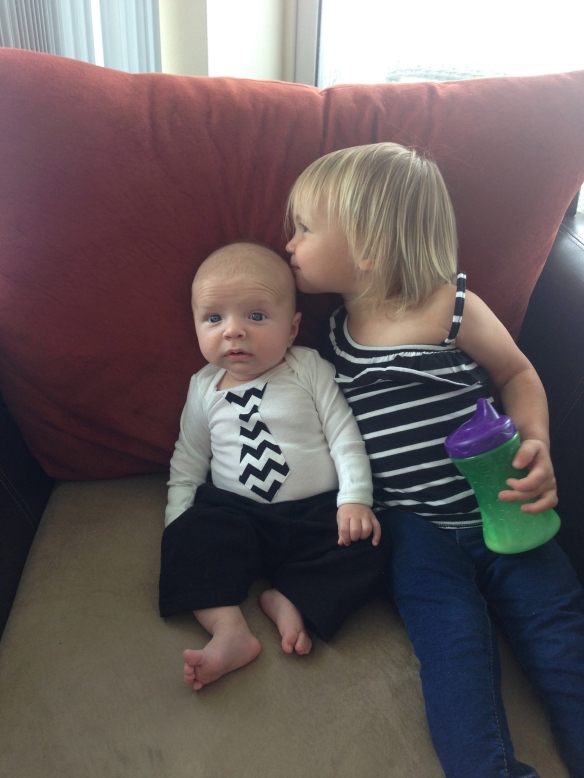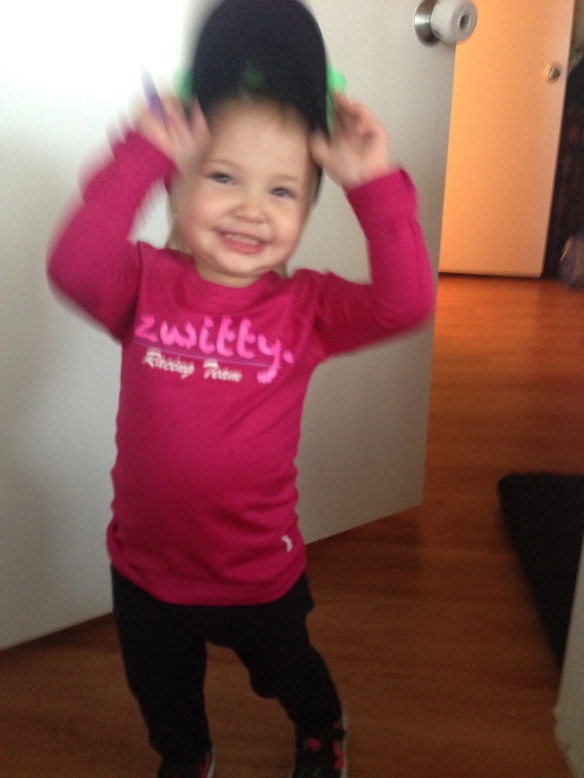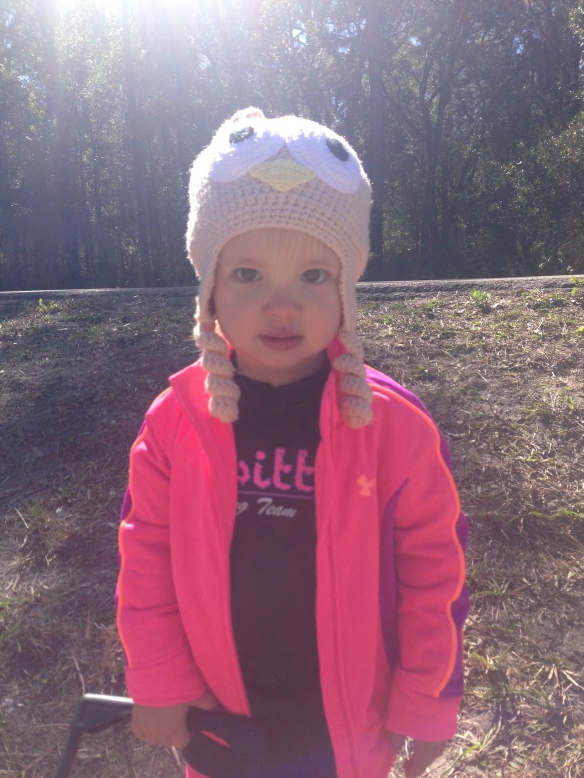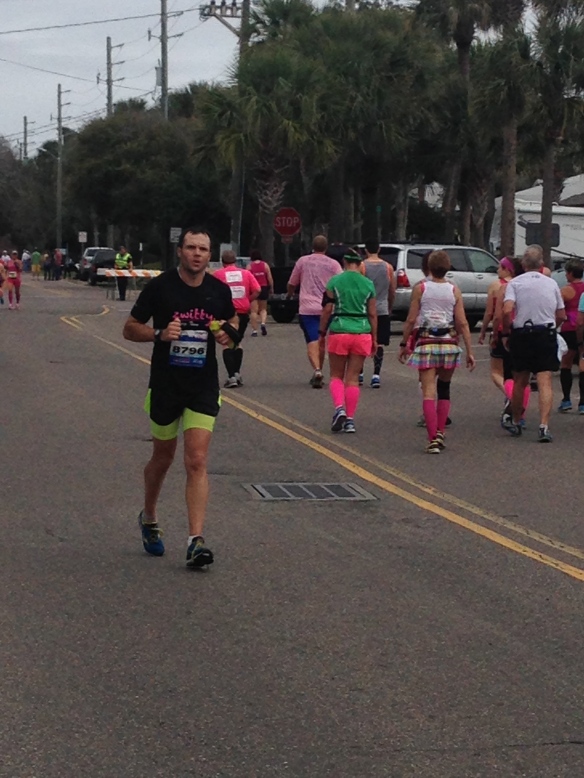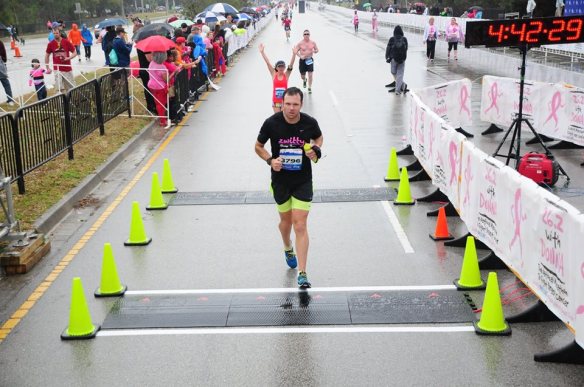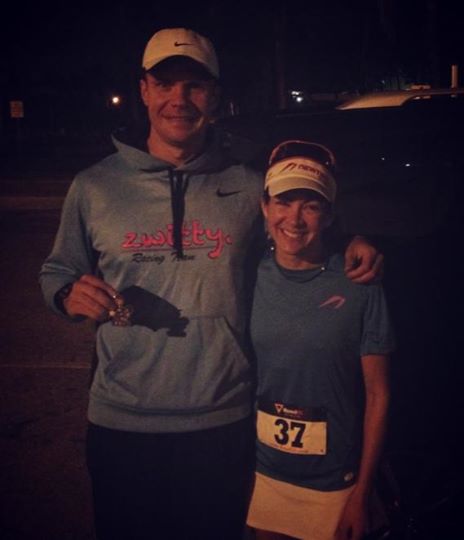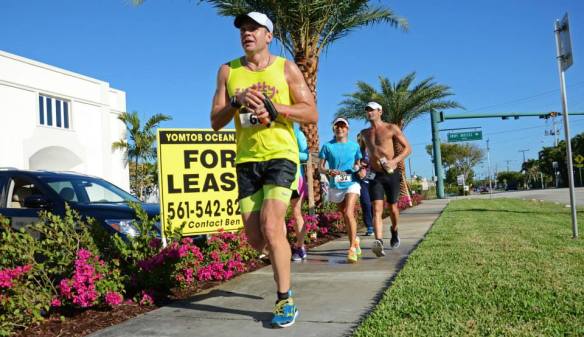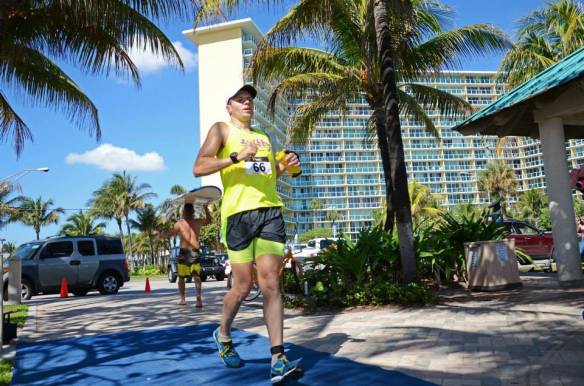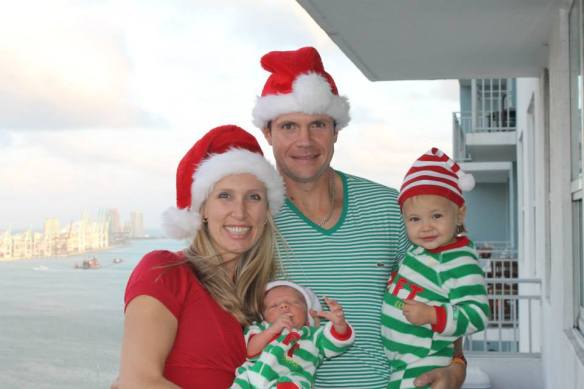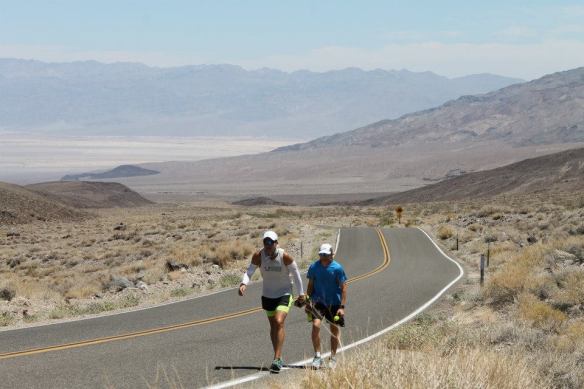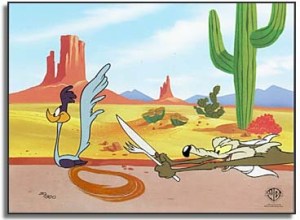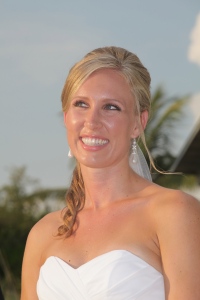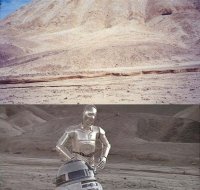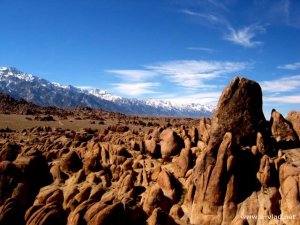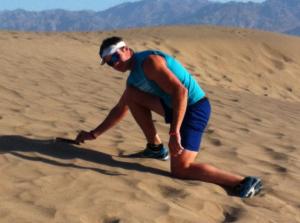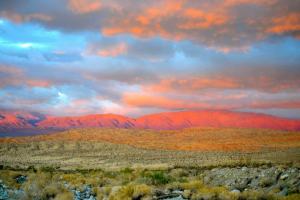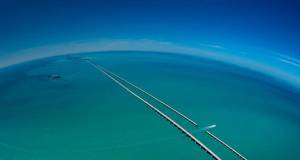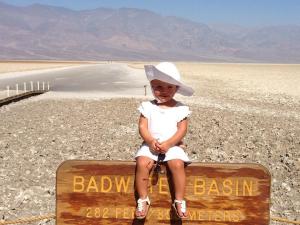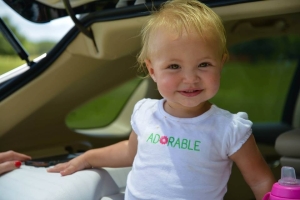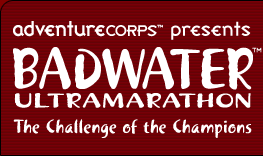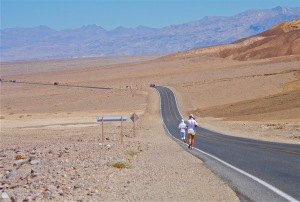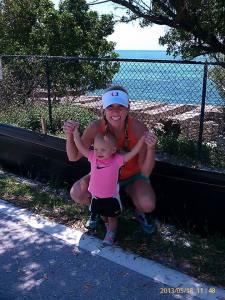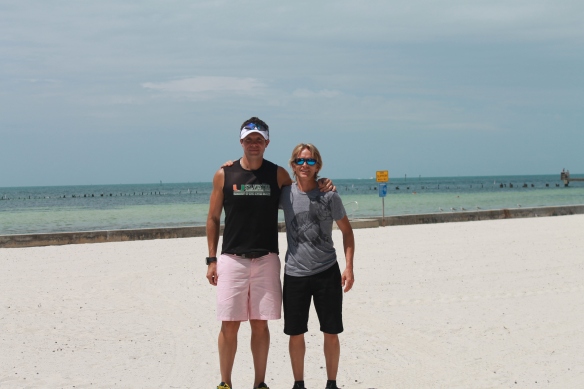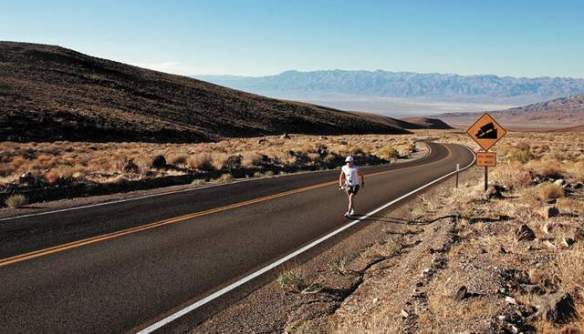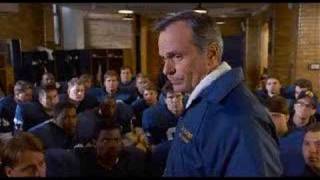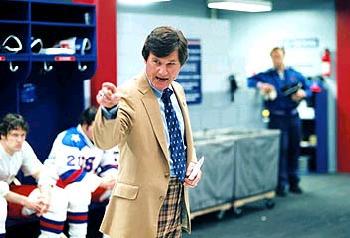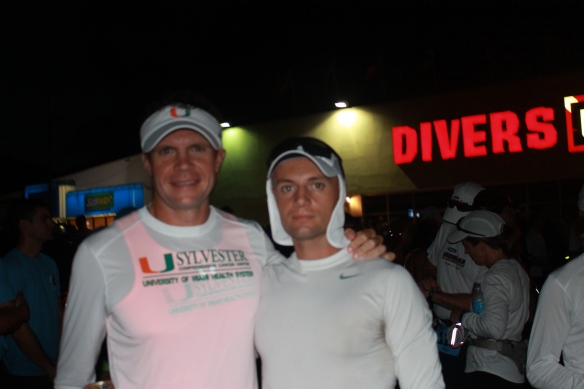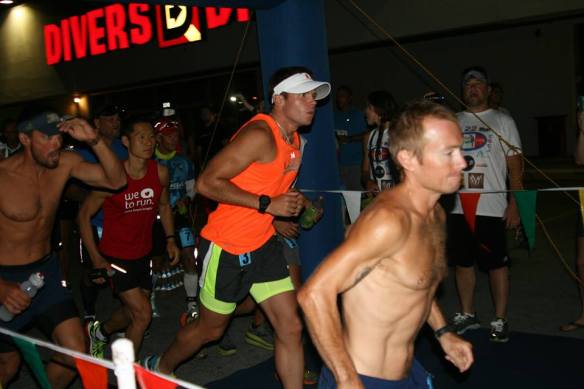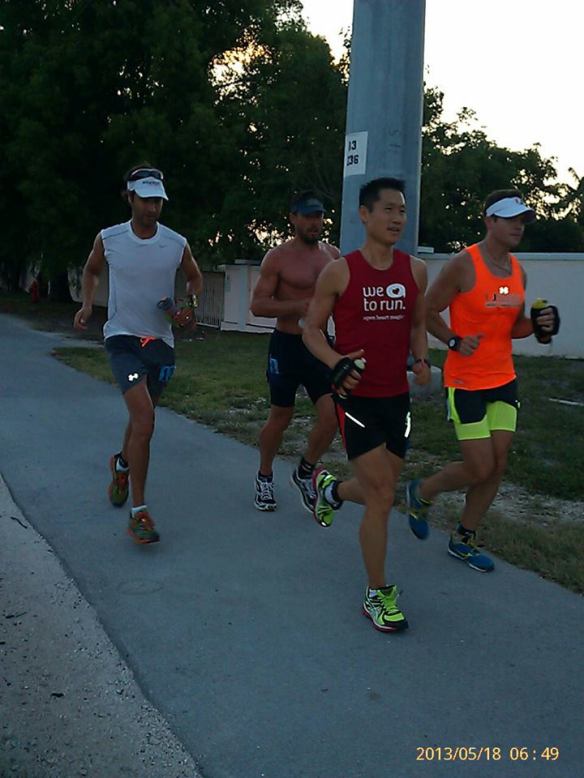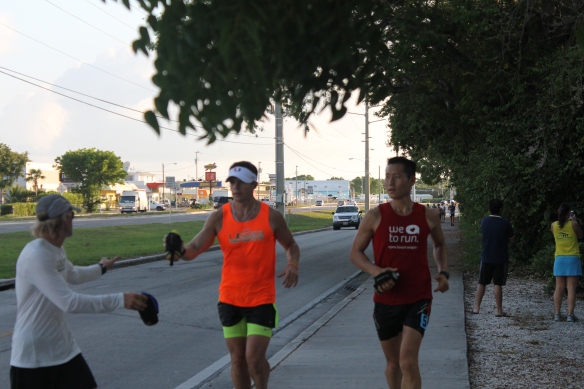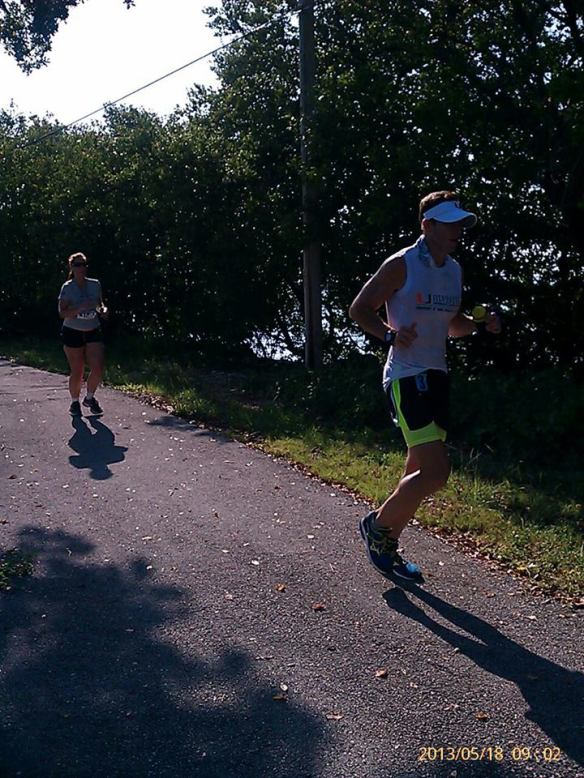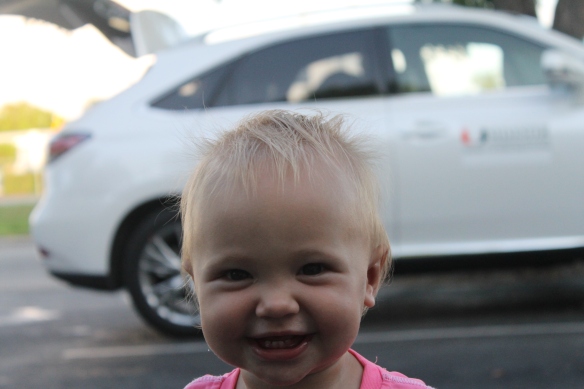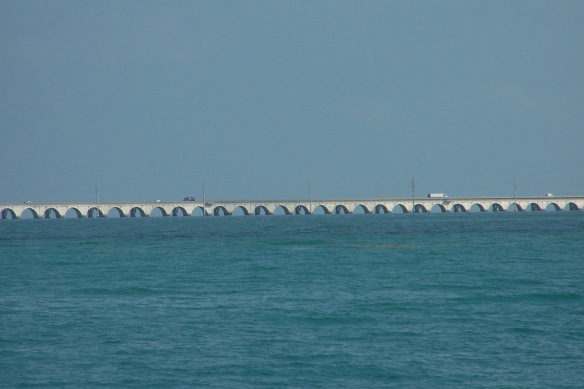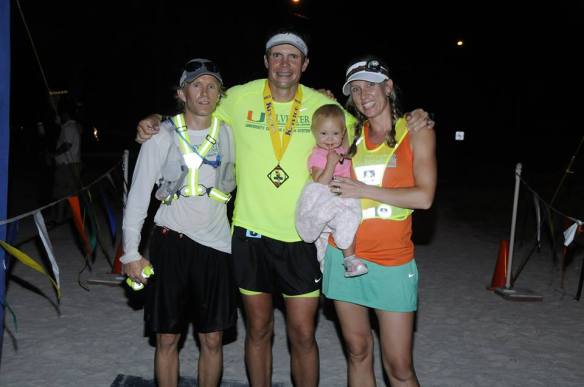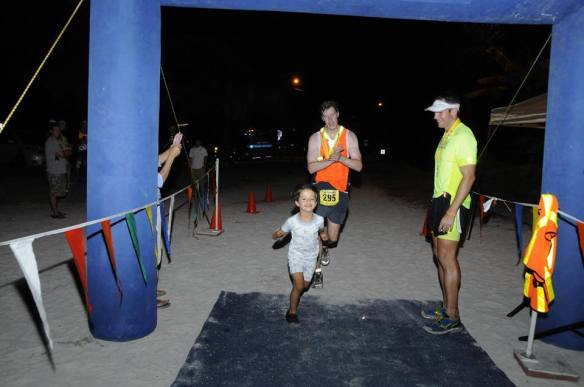Well, this was the big one. The race I’ve been training for since . . . well, since I read Dean Karnazes’ book “Ultramarathon Man” about 7 years ago. Even as I began my ultrarunning career in 2010 and started tackling 50 and then 100 milers, I always defended my sanity to my non-running friends (who were increasingly starting to question it) by stating that my running was “just the tip of the iceberg . . . you should hear about this crazy race in Death Valley where they run 135 miles on a road in the middle of July . . .”
Fast forward about three years and nine completed 100-mile races. I look up and find myself toeing the line at the start of the 10am “elite” wave of the 2013 Badwater 135 Ultramarathon. To my left, there are race legends Dean, Charlie Engle, and a whole host of REALLY fast dudes like Oswaldo Lopez, Carlos de Sa, Harvey Lewis, and others. Also on the line was David Goggins, a tough-as-nails Navy SEAL whose already finished the race twice (both times really fast). And to my right was my Florida friend, fellow Keys 100 competitor, and Salton Sea teammate, Grant Maughan. Our journey was about to begin…
1. Before Badwater
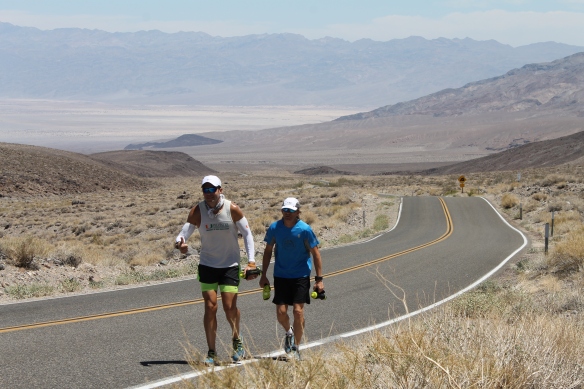
(Training on the Badwater course in June).
Like anyone else’s Badwater journey, my story does not begin on July 15th, but rather years before. Badwater begins as a dream, an ideal. After enough time passes, and enough experience is accumulated, the idea that “hey, I might actually be able to run this thing someday” starts to form. After a while longer, that idea becomes enough of a reality where applying to run in the race isn’t just like buying a lottery ticket. For me, I applied to run this year’s race, feeling fairly hopeful that I would be accepted, having completed 7 100-mile races at that point, and having crewed for Brad Lombardi at last year’s race.
In late February, my hopes were realized and I found out I was accepted into the race. My Christmas Day-like elation quickly faded to a feeling of “holy shit, I need to start training . . . SERIOUSLY!”
So that’s what I did. Every week from February until the race, I ran at least 100 miles a week, often running 2-3 times a day, and trying to run during the hottest time of day here in Miami as much as possible. I also had two “warm-up” races: the inaugural Badwater: Salton Sea 81-mile race in early May and the Keys 100 in mid-May.
At Salton Sea, our team, “Miami Thrice” came in second overall in about 17 hours. Our team consisted of myself, fellow Badwater competitor Grant Maughan, and Brad Lombardi, who would be crewing me at Badwater this year. It was an amazing experience, not just to experience similar terrain to Badwater, but also to spend some time with the Badwater staff, including Chris and Laurie, as well as some Badwater legends, like Oswaldo Lopez, Marshall Ulrich, and Charlie Engle. Plus, it’s an incredibly scenic course:
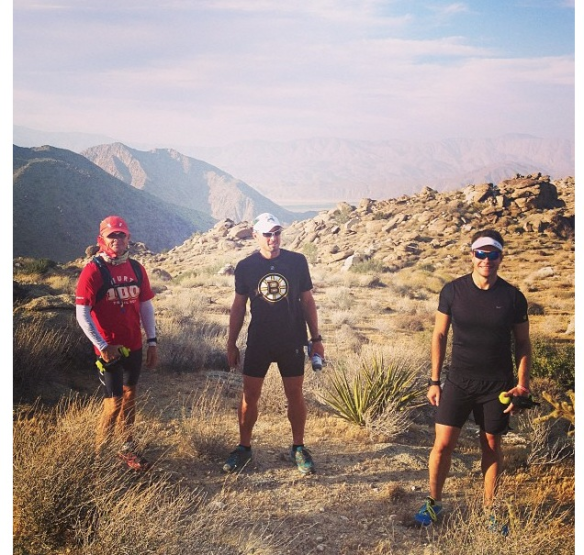
(Team Miami Thrice, on the trail section of the course, a few days before the race).
A few weeks later, I was fully-recovered and standing in Key Largo for the start of the Keys 100, which may be the best warm-up race in the country for Badwater, as it is (1) 100 miles on a road and (2) extremely hot and humid. (Some people posit that the Keys 100 is actually HARDER than Badwater. Those people are wrong. I also entertained similar thoughts prior to actually competing in Badwater. I’ve run the Keys 100 three times, and run it well, but the two races really aren’t comparable in difficulty…)
At any rate, the Keys was a great training run for Badwater, and I actually wound up winning the men’s race in a very close battle with Andrei Nana and Grant (who finished third). Looking back, that race probably provided a bit of training motivation for Grant . . .
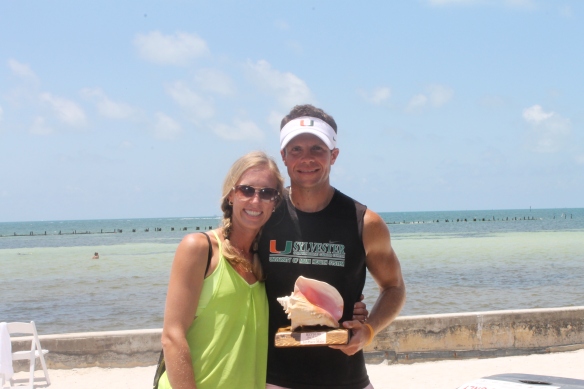
(At the Keys post-race party with Alex and my conch shell 🙂
Fresh off of our second-place “win” at the Keys (Brenda Carawan, a Badwater vet who is training for Spartathlon this year, won the overall race), we were very encouraged and excited for Badwater. So with no races scheduled in June — and after watching “Distance of Truth” about 20 too many times — we decided to emulate Ferg Hawke and plan a “Death Camp” training weekend in mid-June where Alex, my crew chief Kenny Matys, and Zoey would join me in Death Valley for a few epic days of running the first half of the course.
We had an awesome time on the course, and we hit all of our training goals. Zoey also got to experience the Badwater heat for the first time, and this picture went viral and has probably led to her being the most famous member of our family:

(I’m just trying to hold off her modeling career as long as possible…)
After returning from the Badwater course, we felt ready to go physically. Mentally, I also felt good to go, especially because our team would not just be running for ourselves, but to raise money to fight childhood cancer. We partnered with the Sylvester Cancer Center at the University of Miami to raise money for their pediatric cancer center (called “alex’s place”), and would up raising many thousands of dollars for them (as donations are still coming in, the final tally has not yet been counted). For anyone interested in more information about the effort, the Miami Herald did a nice story on the project last Monday:
http://www.miamiherald.com/2013/07/16/3502662/miami-long-distance-runner-raises.html
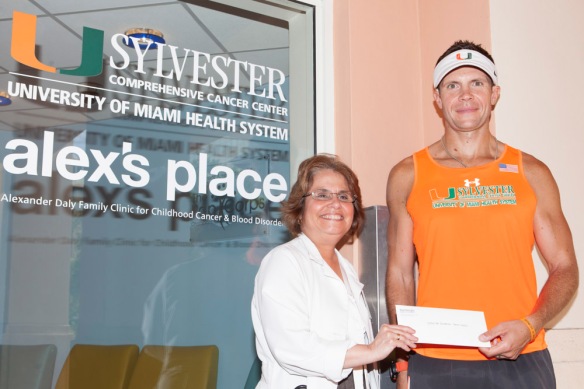
(“Running” a check of some funds raised over to a Sylvester oncologist)
2. Badwater Week
By the time Alex and I met up with our crew in Las Vegas on Thursday, July 11th, we were feeling ready, confident, and hopeful that we would be competitive in the race in four days. All of our crew members except Michele “Zoolander” Graglia, who we would meet in Lone Pine the following day, flew into Vegas on Thursday with Alex and myself: crew chief Kenny Matys, Brad “the Peacock” Lombardi, Greg Fenton, and Canadian Dave “the aquatic Richard Simmons” Carver. (Dave is currently injured, and during the trip, was relegated to water running for his daily workouts. His workouts became so popular that by the end of the trip, he was leading hordes of European tourists in twice-daily aquacize classes!). True story. (Keep in mind I’m a lawyer here and my definition of “truth” is probably different than yours!)
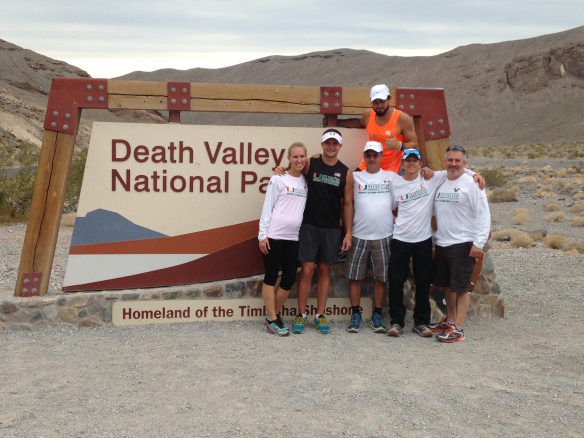
(Arriving in Death Valley)
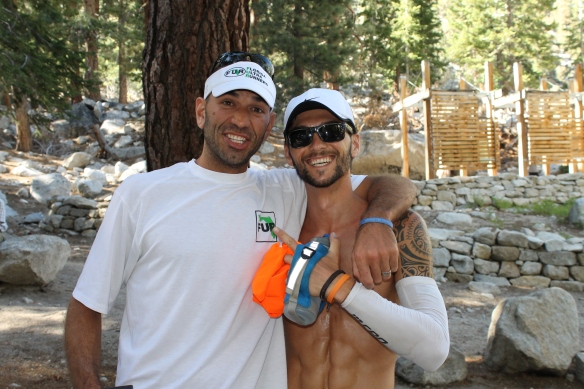
(Michele “Zoolander” Graglia, on the right, telling FUR creator Eric Friedman: “I’m pretty sure there’s more to life than being really, really, ridiculously good looking, and I intend to find out what that is.” He then had an impromptu gasoline fight at the local Chevron station.)
After a quick trip to WalMart to stock our crew vehicles, we headed out on the two-hour drive to Death Valley and our hotel at the Furnace Creek Ranch (located at Mile 17.4 of the Badwater course). About half-way to Vegas, we stopped in a map-dot “town” named Pahrump to use a bathroom and refuel the vehicles. One of our crew members, Brad Lombardi, thought it would be a good idea to buy what was probably a month-old hot dog from the Quik-Stop there. While he thought this was a great idea at the time, his stomach disagreed a few hours later while we were on a training run in Death Valley, and that hot dog is now part of the Badwater course 🙂
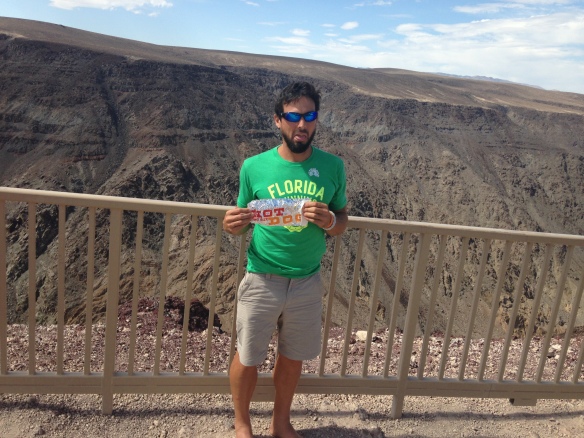
(Brad, making up with the hot dog wrapper the next day).
Brad is 44 years old, but really going on about 8. Actually, during the trip we figured out a good way to figure out Brad’s functional age. It’s called “reverse dog years.” You know how you multiply a dog’s age by 7 to get his “true” age? With Brad, you need to divide by 7 🙂
Okay, back to the main story. After Brad settled the bet between the Quik-Mart workers as to whether anyone would ever buy that hot dog, we arrived in Death Valley and spent the next three days relaxing, seeing the sights, visiting with some race legends, and participating in pre-race activities. I’m glad we got there early, especially for our crew members that have never been in the area. Mainly, though, I’m glad I had a few days to calm my nerves and begin to acclimate to the energy of the race atmosphere. (My heart was pounding from the second we landed in Vegas until about two days later . . .)
Here are some of the cool things we got to see and do in the days leading up to the race:
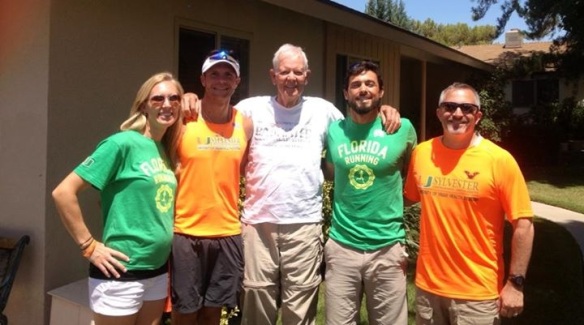
(Having lunch with race legend/historian “Badwater” Ben Jones on the Friday before the race)

(At the Father Crowley outlook (Mile 80), a few days before the race)

(Playing in the Alabama Hills a few days before the race. You can see Mt. Whitney on the left in the picture).
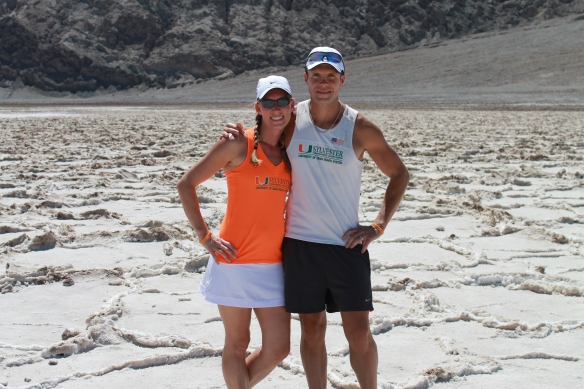
(Exploring the salt pan by the start line on the Saturday before the race with Alex)
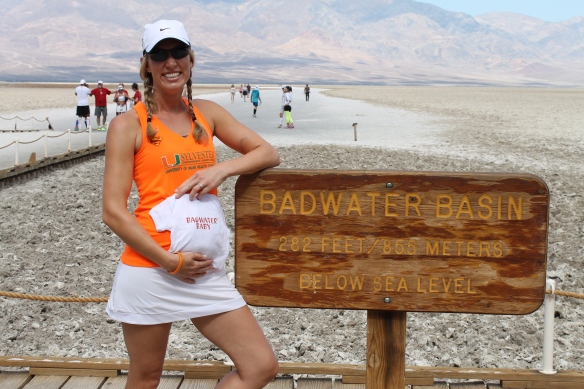
(Alex modeling the “Badwater Baby” onesie for our unborn son. We are currently accepting suggestions for his name. “Stovepipe Krupski” is not on the list being considered) 🙂
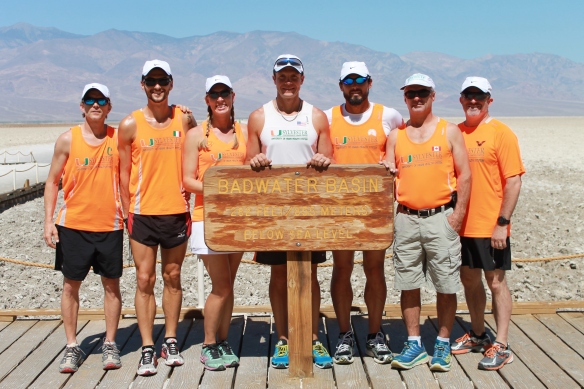
(Official team photo at the Badwater Basin (start line), two days before the race)
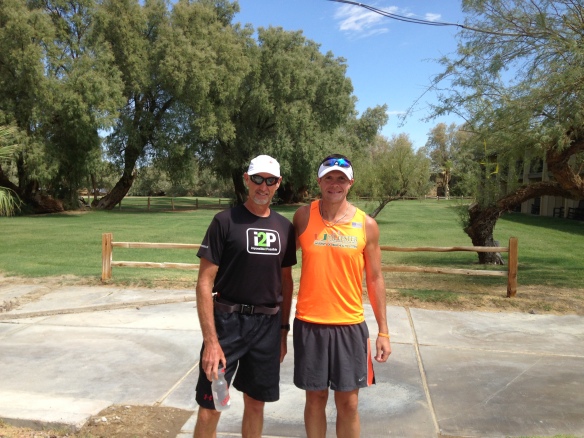
(With race legend and “Distance of Truth” star Ferg Hawke, the day before the race)
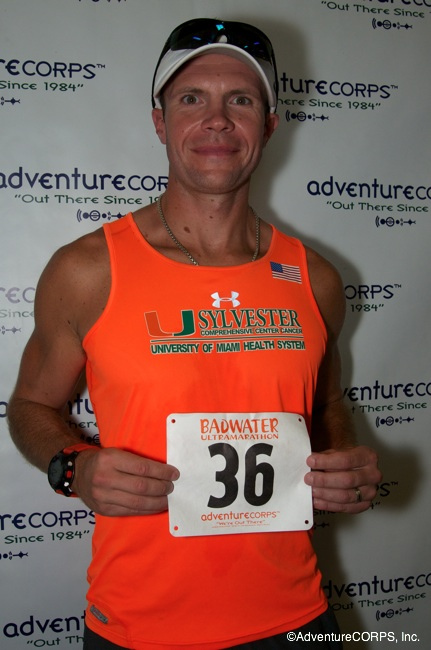
(My pre-race “mugshot” at the registration/check-in, the day before the race)

(The traditional competitor group photo at the Furnace Creek Inn pool)
Okay, after all of the pre-race activities, meetings, tomfoolery, and anticipation, it was finally all over and race day was upon us. The forecast for July 15th was temps above 120, little to no cloud cover, and high winds once we made the turn to Stovepipe (around Mile 35). All of those forecasted conditions were realized in spades.
3. Race Day: The Start (Miles 1-17.4)
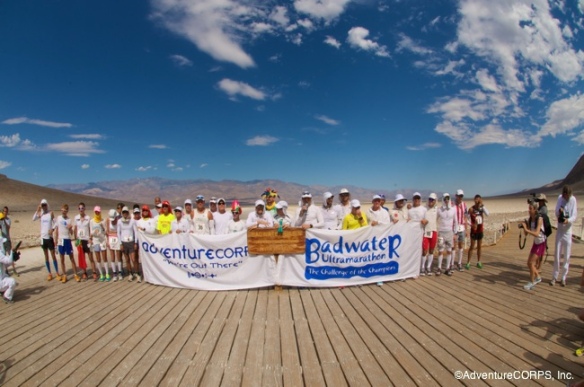
(Group photo for the 10am wave)
Standing on the start line, listening to the national anthem, listening to Chris Kostman tell a few of his trademark cheesy start-line jokes, I felt energetic and focused at the same time. I was just so happy to finally be in the race, after months and months of planning, training, but most of all non-stop thinking about the race.
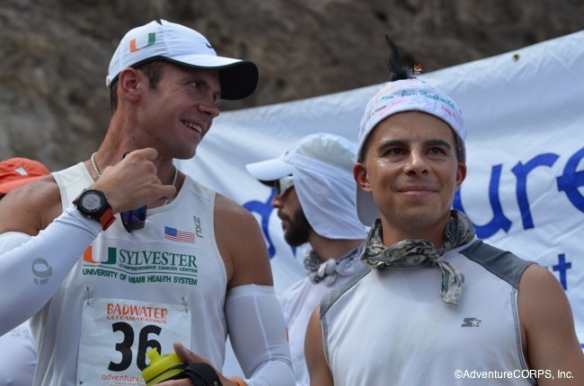
(Sharing a pre-race laugh with David Ploskonka)

(At the start with my buddy Grant. He almost looks as tall as me in this pic) 🙂
As the race started, we were greeted with some unexpected cloud cover for the first 5 miles or so. The race was STACKED with talent this year, and several of the runners shot out of the gate running about a 7-min/mile pace. My plan was to run 8:00-8:30/mile for the first 17 miles into the first checkpoint (Furnace Creek).
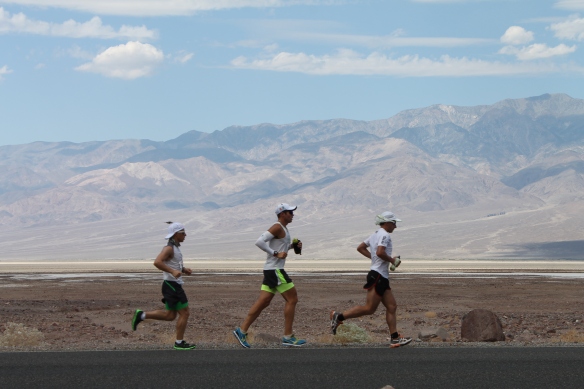
(The early miles. Eventual winner Carlos de Sa is in front of me, Dave Ploskonka (who would finish a few spots back of me) is right behind me. Note the cloud cover (something that would quickly go away…)
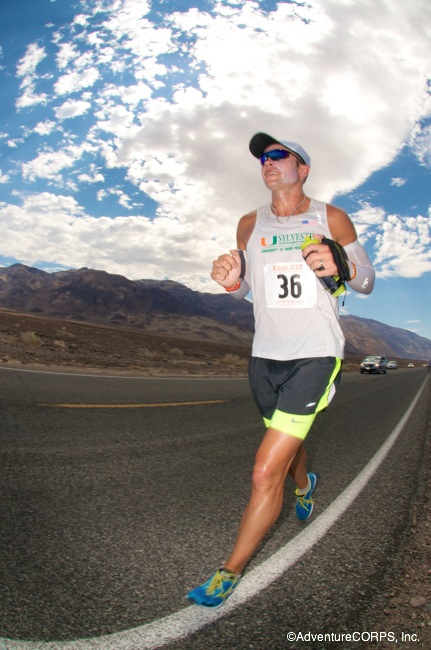
(The clouds are starting to dissipate…)
The first 17 miles were relatively uneventful, and I crossed the first checkpoint in exactly 2:30, right on track. But I realized that it was not as effortless as my training run on the same section four weeks earlier. In fact, by the time I reached Furnace Creek, I was tired. This likely had something to do with the fact it was about 10 degrees warmer and considerably more humid than it was on June 14th during my training run. In fact, I was lucky enough to be running by the official thermometer at the Furnace Creek Visitor Center when a Getty Images photographer snapped the below shot, which appeared in many national outlets, including the WSJ, Washington Post, NY Times, and others:
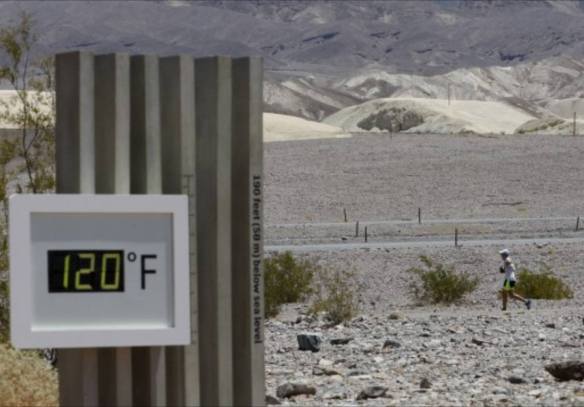
(It was about 12:30 pm when I passed this sign, so about 3 hours away from the hottest point of the day. By the way, thanks Getty Images for the awesome souvenir!)
4. The Crucible (Furnace Creek to Stovepipe — Miles 17.4 to 41.9)
I planned on running this section in about 4 hours. It turned out to be almost 5. As the heat of the day rose and rose, I felt worse and worse. While I got through most of this section relatively unscathed, I was not able to keep my weight up, despite drinking over 100 oz of fluids per hour . . . my sweat rate was actually higher than that!
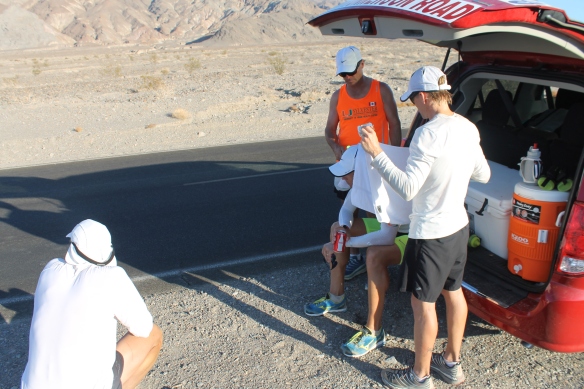
(Getting off my feet for a few seconds)
By the time I had made the turn into Stovepipe, I was nauseous, exhausted, and dehydrated. I knew I would rebound and eventually feel better, but I also knew at this point that I was likely out of contention to challenge for the win. My race would now be about surviving the course as fast as possible.
Looking back, my main mistake was that I tried to hit my original time goal splits, based upon training runs I did on the course when it was 10 degrees cooler and less humid. Had I intentionally slowed down more through the initial 17 miles, my race may have gone a bit differently. But maybe not. At any rate, here I was at the Stovepipe Wells checkpoint, sitting there for 10-15 minutes, at about 7:45 into the race (instead of 6:30 as planned), and facing almost 100 more miles, while feeling nauseous and exhausted. I knew that once night fell and we got over the mountain (Towne Pass), things would start to turn around, but first, we had to conquer the 16.5 mile climb up 5000 feet to the top…
5. The Climb (Stovepipe Wells to Towne Pass (Miles 41.9 – 58.7)
There’s no other way to put it . . . this section blew. Literally. While the 120+ degree temps eventually subsided as we climbed to above 2000 ft, another powerful adversary presented itself . . . very strong winds. From 2000ft to 4000ft, we experienced howling, 30+ mph winds. It got to the point where I could not hear the crew member pacing me, who was literally a foot away from me.
In fact, during the climb my crew caught a good shot of another team’s crew member who stepped outside her van to see just how windy it was:

Suffice to say, it was REALLY windy, and we were all glad once we got above 4000 ft and the wind began to subside a bit. By the time we had reached Towne Pass (4965 feet), the wind was no longer an issue and we were set to begin the very steep 9-mile descent (3500ft of elevation loss) into the Panamint Valley lakebed.
6. The Descent: Towne Pass to Panamint Springs (Miles 58.7 to 72.3)
Zoolander and I ran this entire section together, and I managed to run the 9 miles in about 1:20, which for me, was pretty good at this point, as my energy was low and my stomach was killing me from the obscene amounts of fluid I had been drinking the whole race in order to keep my weight up and body temperature down). If anyone’s ever attempted to run on a full stomach, you know what I was feeling on that descent. My legs felt fine, but my stomach was just really sore. I wanted to walk parts of the downhill so badly, but the descent is literally so steep that it’s MUCH harder to walk it than to run.
By the time I got to the 4-mile stretch on the dry lakebed of the Panamint Valley, leading to the checkpoint at Panamint Springs, my energy was zapped. I managed to get across the lakebed, and the promise of some chicken noodle soup at Panamint Springs got me to the next checkpoint, feeling incredibly low on energy, and pretty nauseous.
7. Rebirth: Panamint Springs to Darwin (Miles 72.3 to 90)
When we rolled into Panamint Springs, I sat down on a bench and my crew got me some chicken noodle soup. I felt beat, low-energy, nauseous, and overall, just plain lousy. Badwater was kicking my butt. Forget about winning this thing . . . I wasn’t sure I would be able to finish. I ate the soup. It stayed with me for a good 3 minutes before my stomach said “no thanks.” After that pleasant little episode, I toyed with the idea of laying down in one of the beds in the cottages there that the race organizers had reserved for weary runners and their crews. For some reason I still cannot explain, I decided against laying down, and instead got back on the road for the 18-mile climb (3500 ft) up to the Mile 90 checkpoint at Darwin. Brad would be pacing me for the first 8 miles or so of this section.
Almost immediately upon getting back on the road after our 15-20-minute break in Panamint Springs, I noticed that my stomach was finally settled down. And my energy was coming back. Here we were, in the middle of the night on a 3500-ft climb 75 miles into the race, and I was FINALLY starting to feel good. So good, in fact, that we started walking at a 12:30-minute/mile clip (which is really fast when on a flat road, let alone uphill).
It didn’t take a half-mile before we started passing other racers. And we weren’t just passing people; we were BLOWING by them. While some of them were from the 6am and 8am waves and I was already ahead of them, time-wise, many were in the 10am wave, such as the SEAL (David Goggins), as well as one of the pre-race favorites from Brazil, Eduardo Calixto, who has won the grueling Brazil 135 the past two years in a row. Many of these guys appeared shocked that someone was passing them so swiftly at this point. But we were finally hitting our stride, and we rode this positive energy all the way to the Darwin checkpoint at Mile 90. We wound up doing this 18-mile climb in about 3:45, which was the amount of time I originally wanted to complete the section. While we had lost a lot of time in the earlier sections, we were back “on pace” going forward. I was pumped, and while we still had 45 miles to go, I knew we were in a good spot for a strong finish.
Note: While I NEVER wish for any fellow competitors to have anything less than their best day out there (I would much rather beat you when you are feeling your best rather than having an off-day), there is definitely something soothing about knowing that other people are suffering as much as or more than you. Before I started that climb up to Darwin, I felt like the biggest wimp in the world, and that the course was affecting me much more than everyone else. Once I saw that most everyone else — including some runners that are MUCH faster than me and whom I really look up to — were having similar issues, it calmed me down and allowed me to focus upon finishing the rest of the race as quickly as possible.
7. The Loooooonng Road (Darwin to Lone Pine: Miles 90-122.3)
For those actually in the race, this 32-mile section is where the race is won and lost every year. It is mostly downhill, and if you have your legs under you, you can really move here. For example, my buddy Grant, who had the race of his life and finished a close second to Carlos de Sa, flew through this section in about 5 hours, solidifying his spot in the top-3 and giving him a chance to pass Oswaldo to secure second place.
For me, I was feeling good, and just looking for a strong finish. Miles 90-100 are particularly fast, and lose a collective 1000 ft of elevation through this section. I flew through these first 10 miles down to the 100-mile marker, averaging about 8-min/mile.
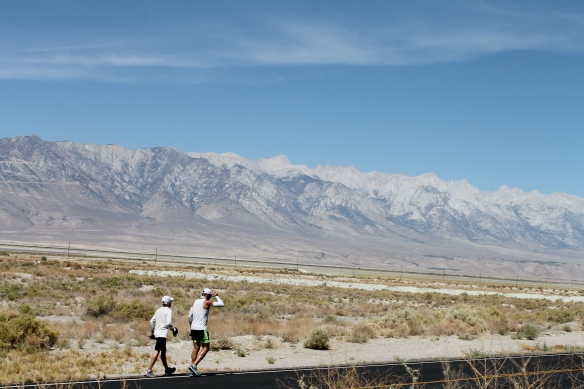
At about Mile 95, with Michele pacing me, we caught up to Dean Karnazes, who, after the race would tell Runners World that he gauged his fitness as good enough for “top 3” or “top 5” in the race. I’ve run into Dean multiple times over the years, but this year was the first time I actually had any real conversations with him. We ran a few miles together when he passed me around Mile 15. He was very nice and outgoing, but then again, it’s easy to be nice and outgoing to someone that you are passing during a race.
At Mile 95, the tables were turned. He was hurting and I was flying. Many people have many different opinions on Dean; the guy is a lightning rod. When he saw me blowing by him, it would not have surprised me if he was less than the jovial dude I talked to earlier on in the race. But he was basically the same guy . . . he greeted me enthusiastically even though he was clearly hurting, and wished me well for the rest of the race. By the way, if I look half as fit as that guy when I’m 50, I’ll be extremely happy!
After passing the 100-mile mark, we still had over 20 miles on this road that never seemed to end until hitting Lone Pine and then turning left for the final climb up Mt. Whitney. The hours I lost earlier in the race were about to come back and bite me in the ass, and would do so in two ways: (1) I had to do this whole 32-mile section in the daylight, which meant that I had to look straight ahead at our goal (Mt. Whitney) for basically the whole section. (You can see Mt. Whitney from many, many miles away, and it never looks like it’s getting any closer. But if you are lucky enough to hit this section in the darkness, you can avoid this bit of mental torture simply by not being able to see the mountain until later down the road); (2) the temperatures were beginning to rise. By the time we hit Mile 110, it was getting hot again. Not the stupid-hot of Day 1, but still around 100 degrees, and certainly enough to slow me down a bit.
At any rate, with Greg Fenton pacing me for most of the section between 110-20, we stayed strong and were able to reach Lone Pine intact, and ready for a solid (and hopefully top-15) finish.
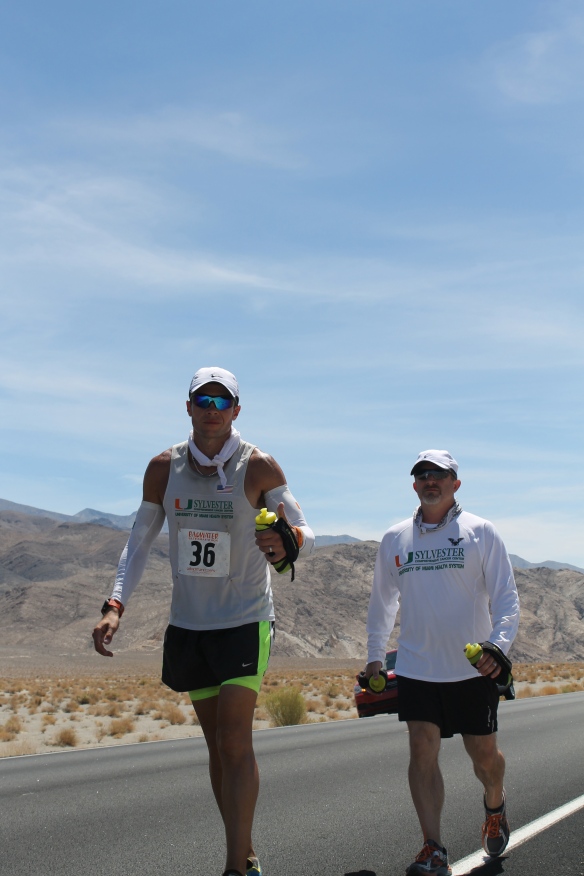
(Closing in on Lone Pine with Greg)
I was really glad that Greg got the opportunity to get out on the road with me and lay down some miles with me, after spending the vast majority of the race to this point either driving or otherwise crewing. Greg and I met while crewing for Brad at Badwater last year, and he has a passion for ultrarunning that is basically unmatched, even though he is just beginning his ultra career, which is being delayed due to some nagging injuries.
8. The Toughest Finish in Ultramarathoning (Lone Pine to Mt. Whitney: Miles 122.3 to 135)
While Badwater is obviously sadistic in the first 58 miles of the course, with 42 rolling miles through the heart of Death Valley followed by a brutal 5000 ft, 17-mile ascent to Towne Pass, one of the toughest aspects of the race is its finish. From 3500 feet of elevation at Lone Pine, the final 12.5 mile stretch of the race literally goes straight up to the Mt. Whitney Portal. From the moment you turn left onto Portal Rd., you start the 4800 ft. climb (to 8,360 ft), though the Alabama Hills, and eventually up the switchbacks of Mt. Whitney itself.
When I hit this section, I did not know my exact position in the standings, but I guessed it was somewhere around 15th out of the 100 or so racers. I was getting reports that race legend Pam Reed was about a half hour ahead of me, and Jay Smithberger was about the same distance behind me. In other words, I was relatively locked into my position, unless something crazy happened. (As an aside, Jay, who I got the chance to visit with the next day, is a phenomenal runner who clocked a sub-14 100-miler in Arizona this past December, which is about 8:00/mile for those keeping score at home, for the entire 100 miles). And Pam is one of the legends of the race; she has won it twice, including once outright. In other words, I was smack dab in the middle of some pretty good company!

(Getting closer)

(Crew chief extraordinaire Kenny)
With Michele, then Greg, and finally Kenny pacing me, we powered through the 9 miles on Portal Road in a little bit over 2 hours. The only thing that now stood in-between us and a solid, top-15 Badwater finish was the infamous Mt. Whitney switchbacks:
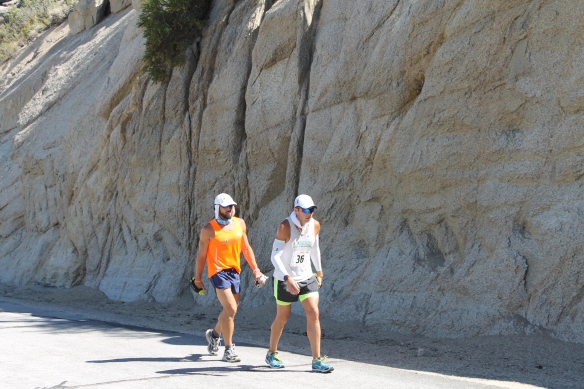
(Starting the switchbacks with Brad at my side)
For the final 3.5 miles, Brad and his calves paced me to the finish. I’m sure he went through the whole range of emotions, not just during these last miles, but during the whole trip as well. As I mentioned previously, Brad attempted Badwater last year but did not finish, a result that has weighed on him for the past year. Yet he gutted his way through several 100s since then, as well as the Badwater: Salton Sea 81-miler this past May with Grant and myself. There are very few people on the planet that love Death Valley in general and Badwater in particular more vigorously than Brad, and it was great to have him by my side at the end of my race.
And while those familiar to this blog know that I make fun of Brad a lot because, well, because he does a lot of stuff that deserves to be made fun of, I am immensely glad he was on our team. Brad was the perfect crew member, and was unbelievably supportive and positive throughout the entire race. I hope to help him complete his goal of finishing Badwater next year.
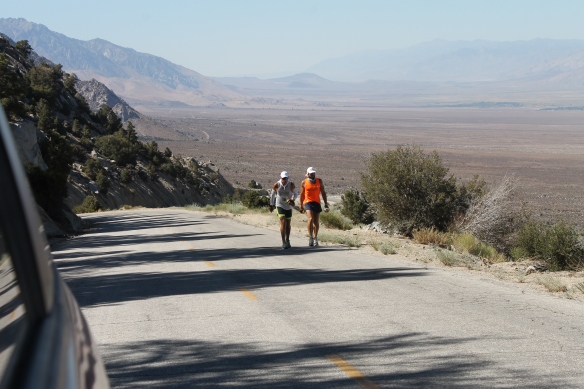
(Getting up the mountain…)
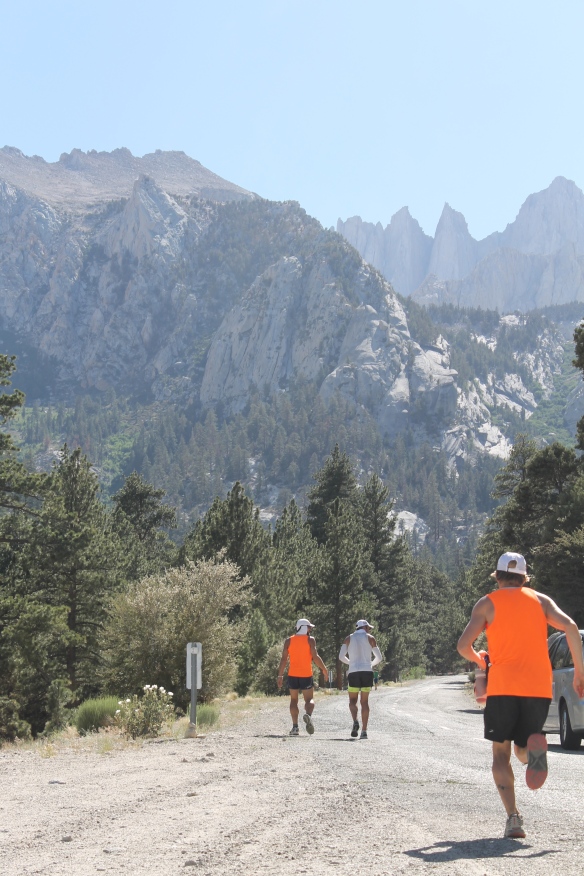
(Almost there!)
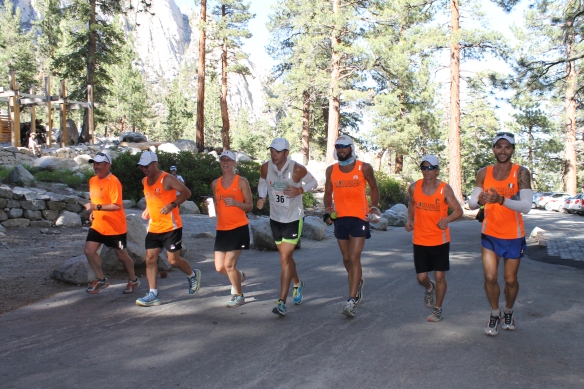
(The final hundred yards, with the whole team)
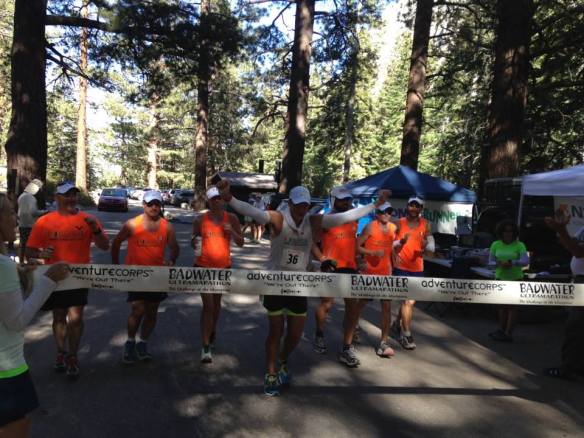
(14th place overall, 30:53)
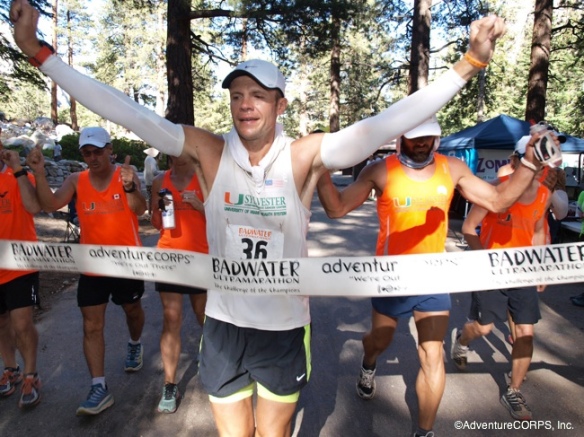
(This is what elation looks like when combined with severe exhaustion) 🙂

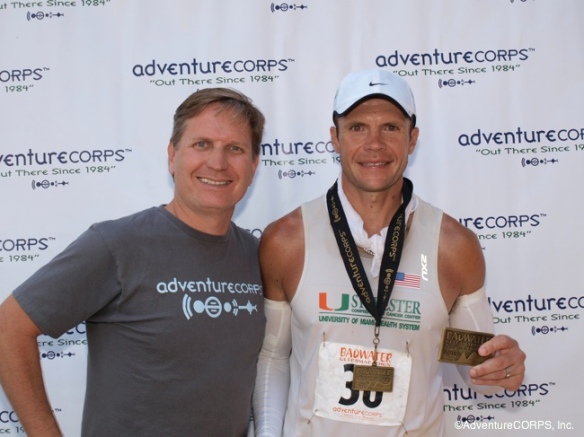
(With race director Chris Kostman and the hardest-earned buckle I’ve ever received!)
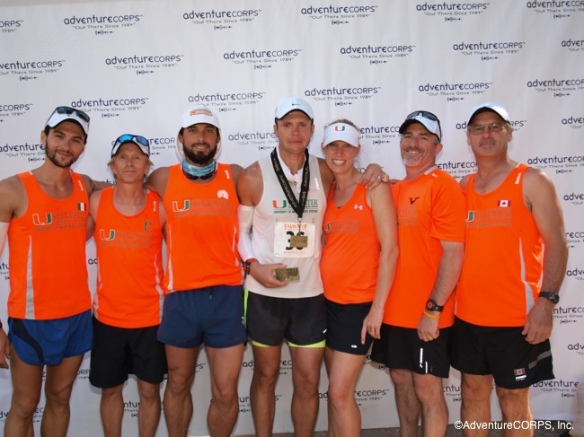
(Well, I managed to keep my emotions in check during the individual pictures, but when my team came up for a few pics, I was openly bawling like a baby) 🙂
9. Aftermath

(At the post-race pizza party the next day with Dean, Charlie, and others)
After the race ended, I pretty much immediately became catatonic and went into a Tylenol-induced coma for the next 15 hours or so. I’ve never been that sore in my life; not even close.
The next day, we made the drive back to Vegas, and my buddy Tony and his fiancee Kristi met us from Phoenix for a nice sushi dinner and a few drinks:
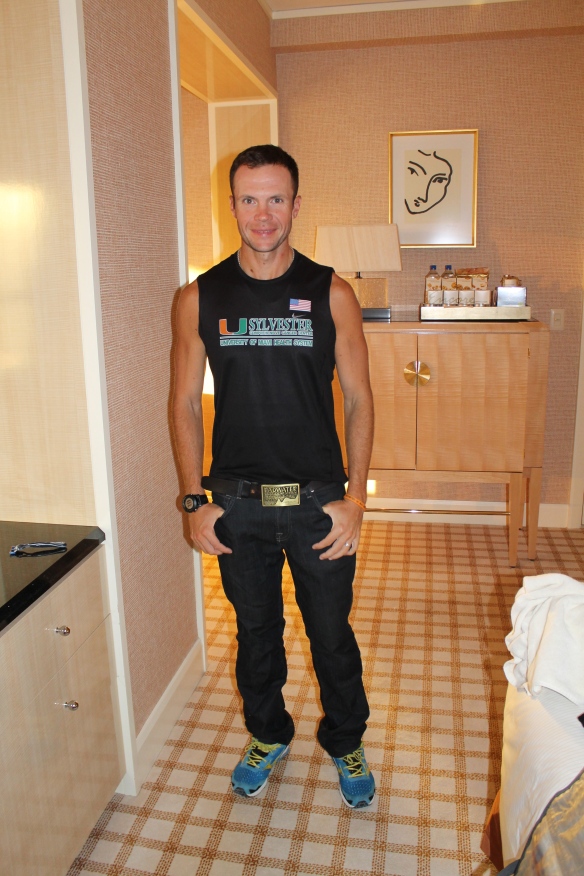
(Sporting the Badwater buckle in Vegas) 🙂
It’s now been a week since the race finished, and I’ve had some time to reflect, let the experience set in a bit, and collect my thoughts.
First, to the extent this hasn’t come out previously, thank you so much to everyone on our team, especially my wife Alex, who has had to put up with me obsessing non-stop about Badwater since February. Kenny is the best crew chief in the business, and was his usual exemplary self. Brad and Michele were amazing pacers, and both have a real appreciation for Death Valley, and hope to be in the race next year. I hope you’re both in it as well. I’m also really glad Dave and Greg were able to join us, and I’m glad they had a good time!
I’d also like to mention a few of my Florida friends who were running the race. First, Grant obviously had the race of his life, and I’m super happy for him and his performance. Like me, he trained like a madman these past 5 months, and no one is more deserving. But even Grant’s performance may not match that of Lane Vogel, who was as sick as a dog BEFORE the race. Yet he somehow found the will to drag his butt to the start line and move himself 135 miles through a course that Dean Karnazes told me was “the hardest or second hardest” of the dozen years he’s run Badwater.
Finally, my buddy Will Glover, who I competed with at Keys and trained with for a weekend in Clermont a few weeks later, gutted out an impressive finish, after all sorts of physical issues, all the while running to raise a lot of money for his own very personal charity.
In the end, while sure, I wish I had Grant’s perfect race, I’m also very thankful for my race experience, and seeing our team rebound from a couple tough patches to finish with a very strong second half. Even if I run this race sometime in the (distant) future, and do it faster than this year, it will be tough to top this year’s experience! Thanks again to everyone who helped make this possible 🙂

(“I will race you again, Badwater. But not yet. Not yet.”)
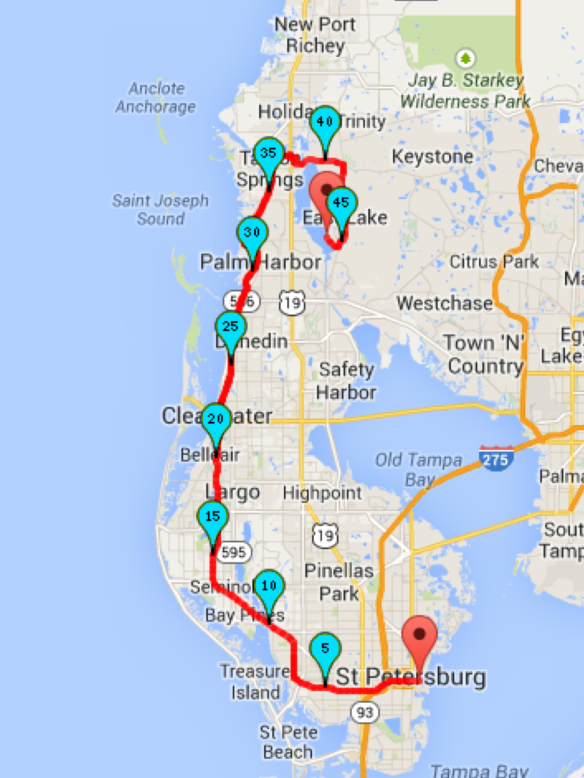 The PTC ultra was conceived by Michael Stork, a local runner who decided to host a FREE event spanning the entire length of the Pinellas Trail. So on August 30th, along with about 75 other runners, I found myself standing at the start of the trail at 6:30 am. It was already over 80 degrees outside…
The PTC ultra was conceived by Michael Stork, a local runner who decided to host a FREE event spanning the entire length of the Pinellas Trail. So on August 30th, along with about 75 other runners, I found myself standing at the start of the trail at 6:30 am. It was already over 80 degrees outside… (Probably not what Abner Doubleday envisioned back in the day…)
(Probably not what Abner Doubleday envisioned back in the day…)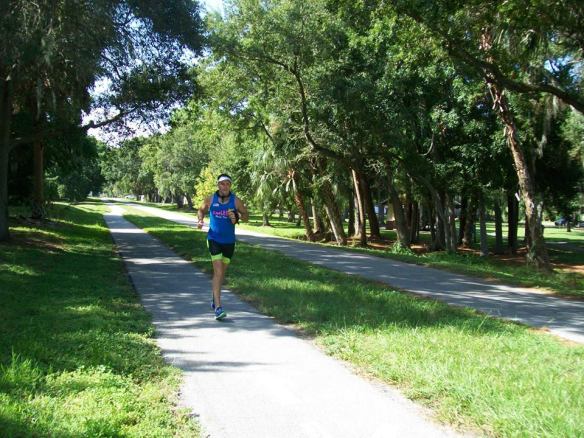 (Yeah, it’s getting hot…)
(Yeah, it’s getting hot…)
 (Luke’s perma-smile, even while running so fast that the background is blurry!)
(Luke’s perma-smile, even while running so fast that the background is blurry!)
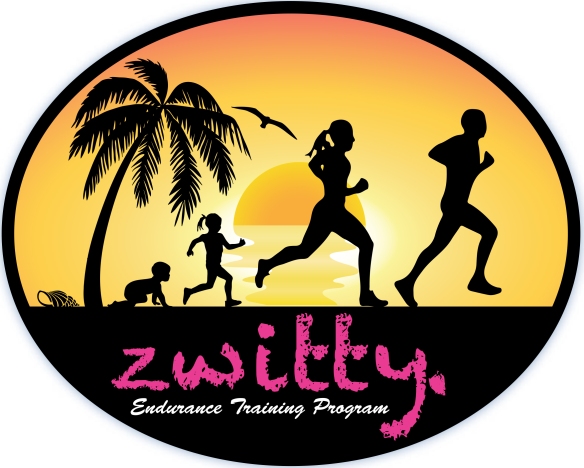 As I say on the website, I’m not looking to get rich off of anyone. What I AM looking to do is to share some of my knowledge (from training and more importantly, from experience) with some people — primarily in Florida — to help them achieve their lofty goals. I genuinely want EVERYONE to succeed at these races, and I know I can help. Our motto is “Focus Your Passion,” and that is exactly what I will help you do. 🙂 The Florida ultra season is just around the corner; can’t wait to see you guys at all the races!
As I say on the website, I’m not looking to get rich off of anyone. What I AM looking to do is to share some of my knowledge (from training and more importantly, from experience) with some people — primarily in Florida — to help them achieve their lofty goals. I genuinely want EVERYONE to succeed at these races, and I know I can help. Our motto is “Focus Your Passion,” and that is exactly what I will help you do. 🙂 The Florida ultra season is just around the corner; can’t wait to see you guys at all the races!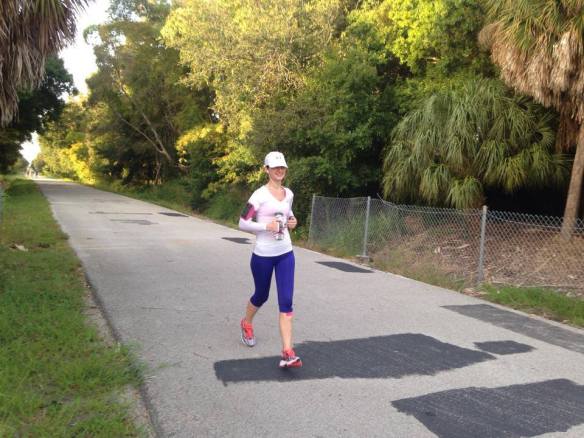 (Aly Venti may need to start looking in her rear view mirror pretty soon…) 🙂
(Aly Venti may need to start looking in her rear view mirror pretty soon…) 🙂

